Yachting Monthly
- Digital edition


Wow, that was fast! Why trimarans are SO much fun to sail – and how to do it
- Theo Stocker
- February 13, 2024
For their size, trimarans can punch well above their weight in speed, cruising potential and fun. Monohull sailor Theo Stocker gets to grips with how to handle one
Humans tend to gravitate into tribes of like-minded enthusiasts, enjoying the encouragement, support and sense of identity, while often looking askance at others; sailors at motorboaters, cruising sailors at racers, monohull sailors at raft, I mean, multihull sailors, and everyone looks askance at jet-skiers.
Large cruising catamarans (40ft now counts as a small one) are a world apart from monohull sailing, but there’s a sub-tribe of sailors dedicated to life on three hulls and builders such as Dragonfly, Corsair, Farrier, and Astus give them plenty of choice.
I’ve been sailing a 22ft (7m) Astus 22.5 this season, with just enough space for a family of four and a minimum of creature comforts. Thanks to her VPLP-designed hulls and 650kg all-up weight, we can sail upwind at 7-plus knots and downwind at over 10 knots with ease, all on a roughly even keel, while the kids play Duplo down below. It can also be beached and is towable behind a car.
Having, it seems, caught the trimaran bug, I wanted to get better at sailing and handling the boat, but my monohull sailing experience and habits were proving something of a hindrance, so we sought advice from some existing trimaran owners, and well as the UK’s top multihull sailors.
Much of the advice will apply to all multihulls , whether two or three-hulled, while other parts are just for small trimarans. I also found that brushing-up some of my rusty dinghy sailing skills helped get my head around what we were trying to do.
To try out our expert tips we went out sailing to see what difference they made. On the day, we got a solid Force 4-5 southwesterly, averaging 16 knots, but fluctuating between 12 and 20 knots true.
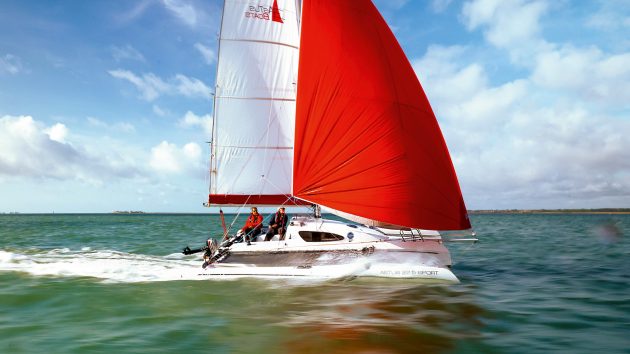
Blasting about on a sporty trimaran is a whole world of fun, but is much calmer than it looks
Trimaran sail trim
One of the biggest differences between a cruising monohull and a multihull is how the mainsail is trimmed. Leech tension on a yacht is often largely controlled by the kicker and the backstay, while the mainsheet sheets the mainsail in and out, predominantly controlling the angle of the boom to the centreline, and there may be a short traveller.
On a mulithull, however, there’s more than enough space for a good, wide traveller. Those who sail on performance monohulls will also be used to this. The sail shape is mainly controlled by the mainsheet, and the traveller then moves the boom towards or away from the centreline.
This is exaggerated on a multihull which has wide shrouds, swept well aft with no backstay, making space for a powerful square-top mainsail with full-length battens. There’s no backstay to bend the mast and flatten what is anyway a pretty rigid mainsail.
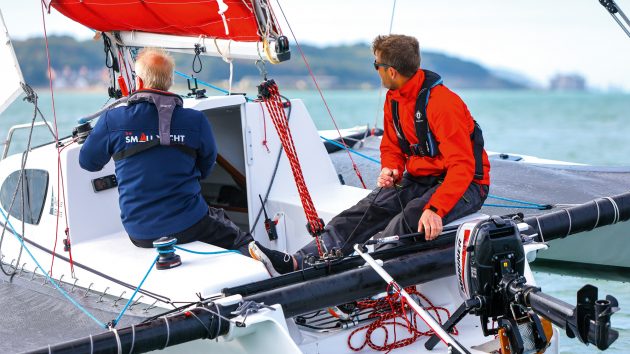
The mainsheet purchase creates enough power to control the leech of the square-top mainsail
Depowering a trimaran
Sailing on a monohull, heel and weatherhelm and eventually a broach give loads of warning that you’re pushing too hard. With straight hulls and little heel, those warning signs don’t really apply to multihulls.
In reality, however, there are a host of warning signals that it’s time to back-off; they’re just a bit different. Even then, there’s still a large safety margin before you get close to danger.
By way of reassurance, with the boat powered up on a beat, Hein, from Boats on Wheels, the boat’s owner, stood on the leeward hull and lent on the shrouds. Even as his feet got wet and the wind gusted at the top of Force 4, the boat didn’t bat an eyelid, thanks to the huge buoyancy of the floats.
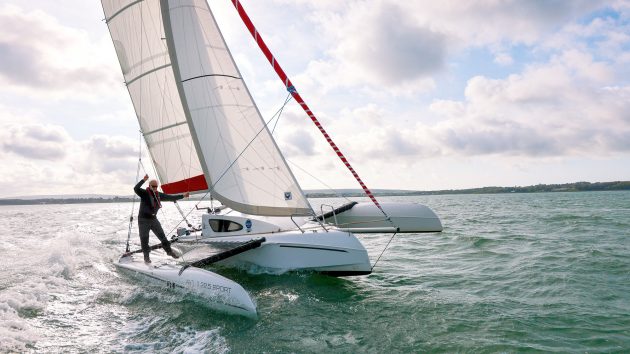
Even with a person on the leeward float the boat was extremely stable
On the water – sail trim
My first inclination was to point the boat as high upwind as possible, pin the sails in and go for height. Doing that resulted in a not-terrible boat speed of 5-6 knots and a good pointing angle.
Free off by a handful of degrees however, and ease the sails just a smidge, and the speed leapt up to 8-9 knots – over 50% more; a huge increase. So, don’t pinch. If you had a decent chartplotter on board, you could find your optimum speed to angle using velocity made good (VMG).
I was also tempted to pinch in the gusts, but it’s better to hold your course and let the speed increase until the main needs easing.
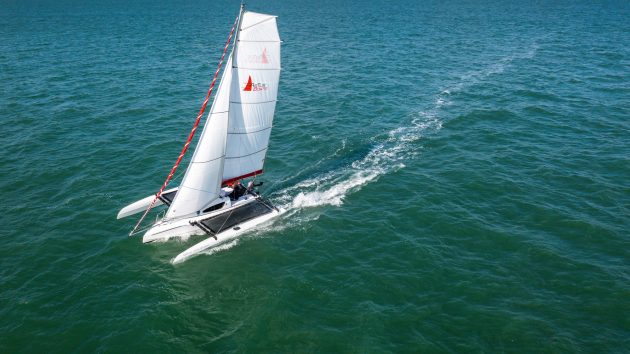
On the wind, it’s time to get the boat fully powered up
If that’s the case, drop the main down the traveller an inch or two or ease some twist into the mainsail and it makes all the difference in the world, but not so far that the top battens fall away and invert – that really isn’t fast. Push too hard and the boat will slow down, largely from the drag of submerging the leeward float and crossbeams. If you’re still overpowered and the main is luffing, it’s time to reef. Downwind is different, but we’ll get onto that later.
After we put a reef in the main, our boat speeds upwind remained largely the same, and the boat was much happier. I came away feeling reassured that even a little trimaran like this would be pretty difficult to capsize, and there were always plenty of warning signs telling me to take my foot off the pedal a little.
Article continues below…

Catamaran sailing skills: Mooring and anchoring a multihull
How do you make an average passage speed of 7 knots, fit in three double cabins and a huge saloon…

Monohull or multihull: which is best for blue water?
As former editor of Yachting World, David Glenn has plenty of experience of both monohull and multihull cruising. Here he…
Tacking and gybing a trimaran
Everyone knows that multihulls don’t tack as well as monohulls. Straight hulls and wide beam don’t lend themselves to turning, especially when coupled with the displacement and fixed keels of big cats. Trimarans are a little easier, with a single central daggerboard to act as a pivot, and one or other of the floats will generally be clear of the water. On the downside, light displacement means that there isn’t much momentum to keep you going through the turn and plenty of windage to stop you.
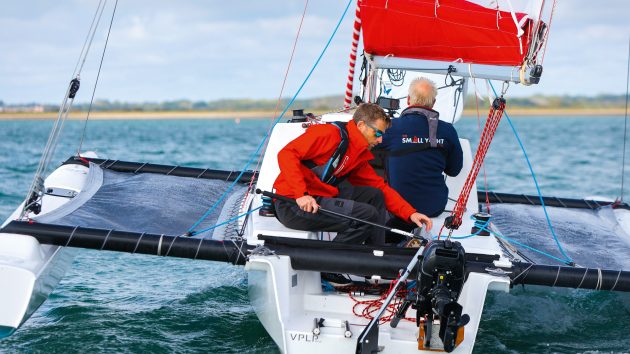
On a trimaran the central daggerboard helps the boat to turn by providing a central pivot point that catamarans lack
Speed is your friend. Build speed up before the tack to give you as much momentum as possible. The helm needs to steer positively into and through the turn, and if necessary, keep the jib backed on the new windward side to help the bow through the wind. Don’t worry about scrubbing speed off, but you don’t want to get stuck in irons.
When it comes to gybing, speed is again key. The turning bit isn’t going to be an issue as you’ll be scooting along, but the faster you’re going, the less load there will be on the sails. The more you slow down, the more the true wind will pile up.
Trimaran sailing skills
Tacks took a bit of practice. It felt plain wrong to jab the tiller across the boat, slamming a big break on in the water but I ended up putting us through the tacks far too slowly, losing a lot of speed. A more aggressive approach worked better. On the Astus, the traveller was between me and the tiller, so the tiller extension needed to be swung around the stern behind the mainsheet onto the new side.
Similarly, old habits of controlling a gybe needed to be modified. With the asymmetric set, we were planing at well over 10 knots, and the ideal is to stay on the plane. Heading dead downwind and centring the main lead to a more violent manoeuvre than flying into the gybe as fast as possible and, as the boom was never that far out thanks to the apparent wind angle, it didn’t need much extra controlling.
Coming up onto the wind after the gybe helped the asymmetric around the front of the jib and to fill on the new side. Stay too deep and it’ll get blanketed by the main. Once we had built up some apparent wind, we could bear away again.
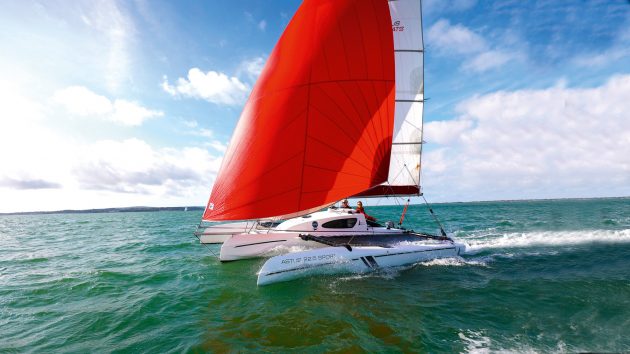
You’ll be on a course deep downwind before you know it, hitting speeds in the double digits
Downwind in a trimaran
Upwind cruising may be fun in a multihull, but bearing away and going with the wind is what it’s all about. Easily-driven hulls, a generous sailplan and light weight mean you can be up and planing, leaving displacement boats wallowing in your wake.
The big difference comes from apparent wind. If you’re in a boat that can do 15 knots downwind in 20 knots of true wind, the resulting wind angles can really mess with your head.
To get going then, says Brian Thompson, ‘Use those leech tell-tales again when sailing downwind and reaching to set the correct twist through the mainsheet, and use the traveller to set the correct angle of the whole sail to the wind.’
As the wind and your speed builds, bear away and trim the main accordingly.
In theory, you shouldn’t need to ease the traveller at all, but you may need to if you want to sail deep downwind. As the gust fades, you’ll find the boat slows down, so you can come back up towards the wind a little to pick up some more breeze, and then bear away as you accelerate again.

Bear away as the boat accelerates. Your course will be something of a slalom as you look to keep a consistent wind angle
This results in something of a ‘slalom’ course, and will also be accentuated if you’re sailing down waves, but that’s all quite normal for apparent wind sailing. Ultimately, you’re looking for a consistent apparent wind angle, even if the resulting wake isn’t straight.
It’s worth remembering that apparent wind reduces the felt effect of the wind, so you need a sailplan to suit the true, not apparent wind speed.
I found that the boat was more sensitive to having a balanced sailplan and trim downwind than upwind, largely because you’ve got almost double the canvas up, with the bowsprit as an extra lever. When weather helm built, I needed to ease the mainsheet to increase twist to depower so that I could bear away. I must admit, getting the boat balanced, sailing fast and light on the helm at 15 knots was something I came away feeling I needed more practice at.
Reviewing the images, I suspect the asymmetric was sheeted in too hard, with too much twist in the main.
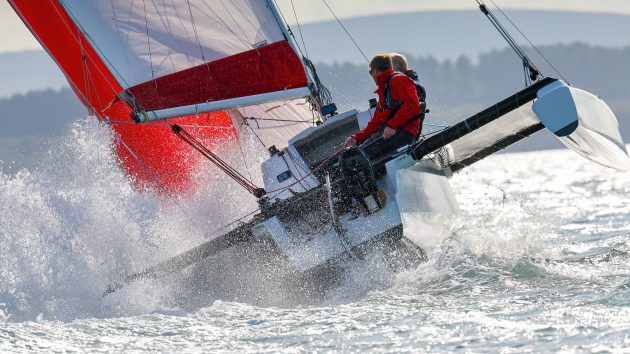
Getting a float fully submerged is when it’s time to back off
On the water
Unfurling the gennaker worked best on a beam reach, giving plenty of airflow over the sail to help it fully unfurl. This was also roughly the fastest point of sail, ideal for getting up some speed for apparent wind sailing. We mostly had the sails set for a close reach, even when we were beyond 120º off the true wind on a broad reach.
It was possible to soak deeper downwind, but lose the apparent wind benefit downwind and our speed dropped off dramatically, prompting us to point a bit higher to find some more speed.
As the boat powered up, it paid to hold a slightly higher angle than I would have done in a monohull for the boat to properly take off and get up into double digit speeds – topping out at 15 knots. Lymington to Cowes would have taken us just half an hour at that speed. It’s easy to give yourself a heck of a beat back!
We were sailing on a pretty flat day, so didn’t have to contend with any waves to speak of. On the recent RTI this is what caused the capsizes of at least two multis, a sobering reminder that you need to sail much more conservatively in lumpier conditions.
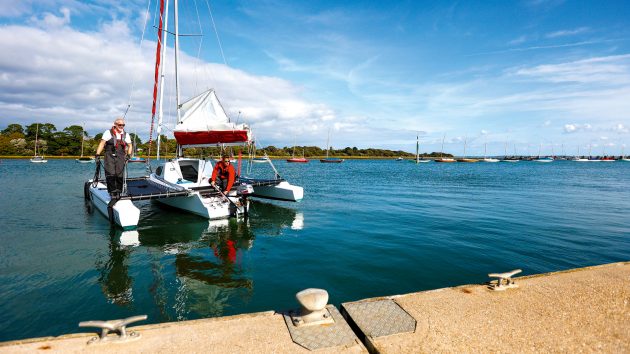
The bows want to point downwind, so a stern-first approach works with rather than against the boat
Coming alongside
A 650kg boat with no draught and plenty of windage feels dreadfully skittish when manoeuvring in confined spaces. Straight hulls with no forgiving curves and fragile-looking sharp bows make berthing tricky. You’ve got a couple of advantages on your side, however. In the Astus, the floats are at pontoon height making stepping off easy.
Whether you have an engine in each hull of a cat, or one in the central hull of a tri, there’s also a lot more leverage to play with to turn the boat and drive her on or off the pontoon. A steerable outboard gives you even more options.
If the boat has a lifting keel or daggerboards, put them down if there’s enough depth to give you a pivot and to resist drifting. Think about getting corners onto the pontoon, rather than putting the boat alongside. On tris, you won’t be able to get to the bow to fend off as it’s too narrow. You can rig a fender up forwards on a line, and two fenders are enough on the flat sides.
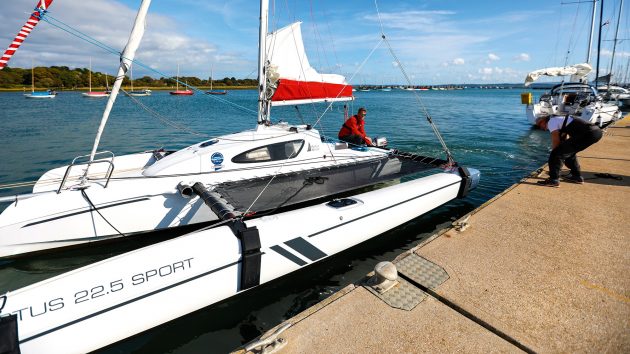
Steering with the outboard towards the pontoon will drive the stern in more; steer away to drive the bow in more
Offshore wind
Coming onto the pontoon with wind blowing off, it worked well coming in stern first. If there’s a tide running, you’ll want to be heading into the tide, so find a spot down wind and down tide to start your approach so you come in at an angle.
On our first attempt we had a bit of tide under us to start with so we came in at a much steeper angle, almost 90º, although this worked out OK in the end.
The crew could then step ashore, taking a line from the stern quarter round a cleat.
Drive forwards against the line and the bow will obediently drive up towards the pontoon, bringing you flat alongside. Getting off was simple, releasing the bowline, and allowing the bow to swing out the before slipping the stern line.
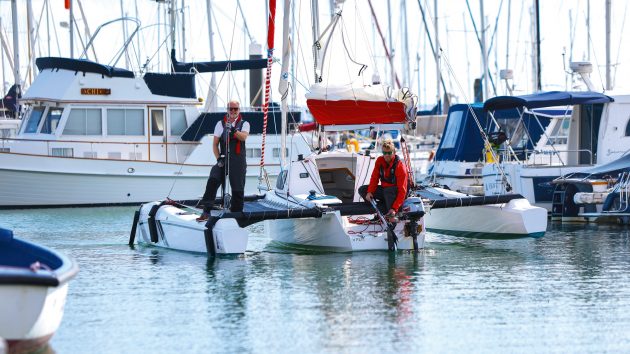
Coming in astern and stopping upwind of the berth meant the bows blew towards the pontoon far to quickly
Onshore wind
Getting onto and off a pontoon with onshore wind proved rather trickier. On our first attempt we came in stern first. The issue was that once we were just upwind of our desired berth and stopped, we lost steerage and the bow immediately blew off with alarming speed towards the pontoon.
Going ahead would only increase the force of the impact, while going astern only increased the bow’s sideways drift. I managed to back out without smashing the bow, but only just, and ended up awkwardly stern to the wind with the bows pointing at the pontoon.
On our second attempt we came in bows first but having aimed at the berth, I had to motor the stern to leeward to stop the bow hitting, making for a rather forceful coming alongside.
On take three, I came in forwards and began ferry gliding towards the berth early, keeping the bows to windward of the stern. Being able to steer with the outboard meant I could go ahead to keep the bow up, and go astern with the engine pulling the stern down toward the pontoon. In this way, it was possible to come in pretty well controlled and parallel to the berth.
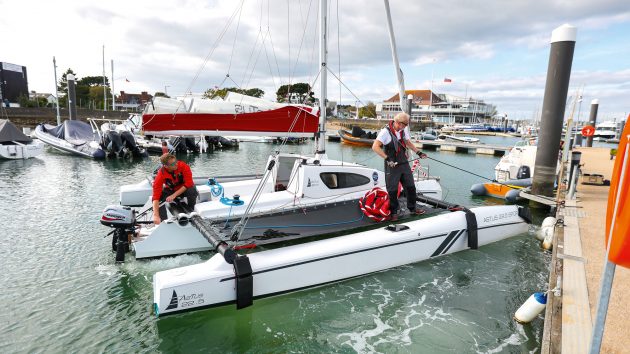
To get out, motoring astern against a bow line pulled the entire boat clear before slipping the line
Leaving was a different proposition all together, as I didn’t want to drag the bow along the pontoon, or to drive hard onto it to spring off. Instead, we rigged a slip-line from the forward cross beam. Going astern against this, and then turning the engine towards the wind, I could pull the stern, and the rest of the boat, out and away from the pontoon.
Keeping power on astern, once we’d reached a decent angle, we slipped the line and went astern, finding steerage way almost at once, with the bow following obediently in our wake with more control than I had anticipated.
Whether the wind is blowing onto, or off the pontoon, you want the engine to be driving or pulling the boat off the pontoon with a line on the corner you are going away from. That way you avoid point-loading fine ends where it’s hard to fender.
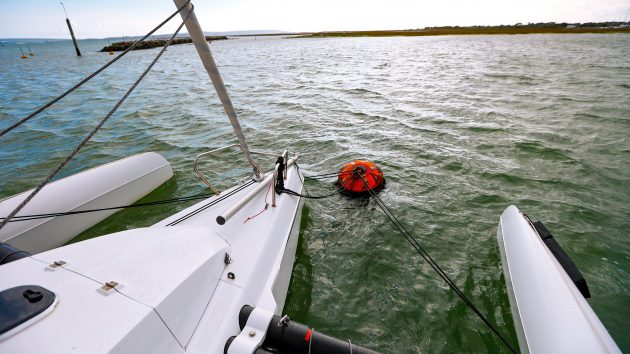
You’ll want a bridle to reduce swinging, but keep the pick up lines on the bow as backup
Anchoring and mooring a trimaran
While mooring a catamaran is complicated by the lack of a central bow, things should be simpler on a trimaran, and they are, mostly. Picking up a mooring buoy from the main hull bow with a low freeboard and dropping the pick-up line onto a cleat is easier even than a monohull.
The bow may be narrow, but for any lines that pass through a ring on the buoy, you still need to take it back to the same cleat to avoid chafe. That should be it, but windage from the two extra bows and the lack of keel mean the boat can dance merrily around the mooring buoy in a breeze.
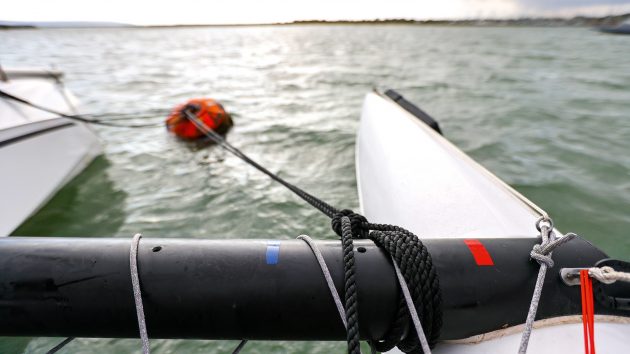
Rig the bridle so the buoy sits to one side to stabilise the boat
In practice, we found that a trimaran benefits from a mooring bridle in the same way that a catamaran does. It can’t be rigged from the floats’ bows, as there are no mooring cleats, so a line passed around the outboard ends of the forward beams gave a pretty good angle, again with long lines passed through the mooring and back to the same side. The main pick-up lines stay as a safety backup.
The other trick is to rig the bridle asymmetrically so that the buoy sits to one side or the other, just enough to not be dead head to wind, making it much more stable in the wind.
On the plus side, the lack of draught or keel means that you’ll nearly always be lying head to wind, so the cockpit remains nice and sheltered whatever the tide’s doing.
We ran out of time on the day to try anchoring, but rigging a bridle, effectively a long snubber to a point on the anchor chain in a similar way wouldn’t be tricky.
If you needed not to swing, or to behave more like deeper boats nearby, hanging a bucket over the stern can help, or there’s always anchoring with a kedge, either out ahead in a V, or in line astern.
Enjoyed reading this?
A subscription to Yachting Monthly magazine costs around 40% less than the cover price .
Print and digital editions are available through Magazines Direct – where you can also find the latest deals .
YM is packed with information to help you get the most from your time on the water.
- Take your seamanship to the next level with tips, advice and skills from our experts
- Impartial in-depth reviews of the latest yachts and equipment
- Cruising guides to help you reach those dream destinations
Follow us on Facebook , Twitter and Instagram.
Free Shipping in the US on Orders $75+

Item added to your cart
The complete list of trimarans.
There is no single trimaran that is best for everyone. Where some prefer luxury cruisers for long trips with family and friends, others might opt for a high performance racing tri for thrilling rides at breakneck speeds. With the recent spike in trimaran popularity, these days there is a perfect tri for every sailor. So to help prospective trimaran owners decide which boat is just right for them, we here at WindRider have put together a comprehensive list of the best trimarans on the market today! Read through for simple at-a-glance trimaran comparisons of boats both big and small, exhilarating and relaxing, and for all price points.
Jump to a specific sailing trimaran: Neel Weta Corsair WindRider Dragonfly Catri Astus Hobie Sea Pearl Farrier Sea Cart Multi 23 Triak SeaRail Warren Lightcraft Diam Radikal Challenger

Known for their award-winning luxury trimarans, NEEL is based in La Rochelle, the capital city of sailing in France. NEEL trimarans are built for fast cruising with an average cruising speed of about 10 knots, and are even configured to facilitate that sustained speed under motor propulsion. The NEEL 45 was notably named Cruising World’s Most Innovative Vessel in 2013, and by all accounts is an easy-to-sail, high performance boat that is just plain fun.
At a glance:
Models: NEEL 45, 65
Length: 45’ – 65’
Cost: $$$$$
Use: Luxury cruiser

A fan favorite, Weta trimarans are fast, stable, and remarkably easy to rig. This single-sailor tri has a capacity of up to three, and the ease with which it can be transported and stored makes this a great, versatile boat for beginners. The Weta was named Sailing World’s 2010 Boat of the Year, and one ride is enough to know why: simply put, the Weta is an absolute ton of fun to sail regardless of skill level.
Models: Weta
Length: 14’5”
Cost: $$ $$$

The high-end Corsair trimaran definitely holds its own in the categories of versatility, performance, and convenience. Boasting a rigging time of 30 minutes from trailer to sailor , the Corsair 42 – whose convenient folding amas makes trailering possible – is a simple option even for single sailors, though cabin space is suitable for two adults. These boats are wicked fast, capable of reaching speeds of 20+ knots, and were made for skilled sailors seeking solid construction and high performance vessels, not for beginners.
Models: Pulse 600, Sprint 750 MKII, Dash 750 MKII, Corsair 28, Cruze 970, Corsair 37, Corsair 42
Length: 19’8” – 37’
Cost: $$$$ $
Use: Sports cruisers

Built for the sailor who wants to maximize the joys of sailing while minimizing any hassle, WindRider trimarans are notoriously fast, very safe, and a blast to sail from start to finish. With several models that can hold between 1 and 6 riders, including adaptive designs to allow participation from sailors of all levels of mobility, there’s something to suit every sailor’s needs. The WindRider 17, an exhilarating ride perfect for families or camper sailors, has been known to reach speeds of up to 20mph. This easy day sailor goes from trailer to sailing in under 30 minutes and is sure to fit in perfectly with whatever adventures you have planned.
Models: WR 16, 17, Tango, Rave V
Length: 10’11” – 18’3”
Cost: $ $$$$
Use: Day sailor

The Danish-built Dragonfly trimarans come in a variety of models ranging from 25’ – 35’, all known for their spry performance, comfortable ride, and ease of use. Every model comes equipped with the unique “SwingWing” feature, a motorized system that can unfold the amas even while the boat is already underway – making it accessible to marinas and slips, and even makes trailering possible. Perfect for those who don’t want to sacrifice their comfort for high performance, the Dragonfly can breeze along at 13 knots while remaining one of the quietest compact cruisers out there.
Models: Dragonfly 25, 28, 32, 35, 1200
Length: 25’ – 39’

Designed for both safe cruising as well as for high speed racing, Catri trimarans will make your day. Especially noteworthy is the Catri 25, a stable yet wildly fast foiling trimaran with accommodations for up to 6 people. With profiles optimized for speeds of 25+ knots when foiling, this is no beginner’s sailboat. The special attention paid to stability in the foil design allows the Catri to be a single sailor vessel, even at foiling speed, with no special physical abilities. Whether you’re taking a small crew for longer rides at shuddering speeds or bringing the whole family along for a shorter, but still thrilling sail, the Catri is truly one of a kind.
Models: Catri 25
Length: 25’
Use: Cruiser/racer

A popular brand of trimaran in Europe, Astus has recently made its way to the US market to the delight of sailors on this side of the pond. Designed to offer maximum pleasure with minimum hassle, all models of Astus trimarans are fast to set up, quick on the water, inherently stable, and always a joy to sail. Their outriggers are mounted on telescopic tubes for easy stowage and towing, and can even be extended and retracted on the water for access to narrow passageways and monohull slips in marinas. With models in all sizes and price points, Astus trimarans are a great option for any sailor.
Models: Astus 16.5, 18.2, 20.2, 22, 24
Cabin: Some models
Length: 16’ – 24’
Use: Sport cruisers
HOBIE ADVENTURE ISLAND

Great for beginners and adventurers alike, the Hobie Mirage Adventure Island series is nothing if not just plain fun. With the option to use as a kayak or as a very basic trimaran, the Hobie is transportable, versatile, unintimidating, lightweight, and wonderfully affordable. The pedal system known as “Mirage Drive” allows a person to pedal the kayak using their legs for an extra kick of movement in slow winds. Amas tuck close to the main hull for docking or car-topping, adding serious ease and convenience to the exhilarating experience of the Hobie.
Models: Hobie Mirage Adventure Island, Mirage Tandem Island
Length: 16’7” – 18’6”
Use: Convertible kayak/trimarans

Best known for its use in camp cruising excursions, the Sea Pearl offers a roomy main hull and particular ability to sail in very shallow waters, making beaching and launching a breeze. The lightweight Sea Pearl trimaran is easy to tow, and the larger-than-expected cabin opens this vessel up for overnight adventures with plenty of storage space. The simple design makes the Sea Pearl notoriously low maintenance, and the ease it takes to rig and sail it add to the overall delight of owning this boat.
Models: Sea Pearl
Length: 21’
Use: Camper cruiser

Quick, lightweight, roomy, and trailerable, Farrier trimarans are made for versatility to fit every sailor’s needs. Different Farrier models are available in plan or kit boat form for those who appreciate building their boat themselves, but of course, also as the full production sail-away boat for the rest of us. Single-handed rigging and launching takes under 10 minutes from start to finish, minimizing hassle and getting you on the water fast. All non-racing Farrier designs use a minimum wind capsize speed of 30 knots or more to ensure safety for all those aboard. Add the roomy cabin and high speed capabilities to the equation and you’ve got a boat that is great fun for everyone.
Models: F-22, 24, 25, 82, 27, 28, 31, 9A, 9AX, 9R, 32, 33, 33R, 33ST, 36, 39, 41, 44R
Length: 23’ – 39’4”
Cost: $$$ $$
Use: Sport cruisers/racers

One of the biggest names in the game, SeaCart is internationally noted for its high performance trimarans that far exceed expectations for a production boat of its size. The SeaCart trimaran performs as brilliantly off the water as it does on with its super-light and efficient harbor folding system, making light work of trailering. Notoriously easy to manage and maintain, the SeaCart 26 One Design is the ultimate day racing trimaran, designed for both course and inshore/coastal distance racing. Absolutely worth the international buzz it has garnered, the SeaCart is a thrill from beginning to end.
Models: SeaCart 26
Length: 26’

A high performance racer class, the Multi 23 is a lightweight, powerful trimaran known for its wicked speed of up to 25 knots. Multi trimarans of both available configurations were designed to give beach cat thrills and speed without any of the stability or seaworthy concerns. Open ocean sailing is no issue for the Multi’s big bows, which do their job to keep her stable. Built for sailors with a need for speed, the Multi makes a perfect weekend boat for racers, especially those with a taste for boat camping.
Models: Multi 23
Length: 23’

Another dual outrigger sailing kayak/canoe design, the Triak trimaran was designed to be effortless and fun, especially for beginners. Paddle the kayak with sails furled, use the foot pedals for an extra kick of momentum, or sail with just the mainsail – the only boat in its class to feature an asymmetrical spinnaker – for exhilarating speeds and a blast on the water. Car-top the Triak anywhere for a quick sail or plan for a week long expedition, but always count on having a great time on this easy little boat.
Models: Triak
Length: 18’
Use: Convertible kayak/trimaran

SeaRail trimarans are known for being affordable, light weight, trailerable trimarans that offer the perfect combination of exciting and relaxing experiences to a wide range of sailors. Whether it’s day sailing with your family, resort or camper sailing, SeaRail trimarans are ideal leisure vessels. Leave the hassle to the other boats – the SeaRail takes you from trailer to sailor in 15 minutes. But don’t let its reputation as a leisure tri fool you: if speed is what you want, rest assured that the SeaRail can deliver that as well.
Models: SeaRail 19
WARREN LIGHTCRAFT

Warren Lightcraft trimarans , another example of a convertible kayak-to-sailboat option, are known for their aesthetically pleasing designs that are also, as the name implies, very light for simple transportation and ease of use. Convert the kayak into a fast, high performance sailboat in just minutes, fly around on the waves all day long, then simply car-top the 68lb Warren for a maximum enjoyment, low-hassle day on the water. Perfect for sailors and paddlers of all skill levels, the Warren Lightcraft is the best of both worlds and an absolute joy to sail.
Models: Warren Lightcraft
Length: 15’6”

Built strictly with racing in mind, the Diam 24 is a light, powerful one-design class trimaran and a notoriously exceptional performer. Boasting blistering speeds of up to 30 knots, Diam trimarans are not intended for beginners. For racers who crave the very best in terms of intense speeds, smooth handling and impeccable performance, the Diam is the red-hot one-design racing tri for you.
Models: Diam 24
Length: 24’

For the sailor who prefers the finer things in life, the Radikal 26 delivers. Perfect for bringing the whole family out for a day on the water, this high performance, trailerable sailing trimaran strikes the most luxurious balance between quicksilver speeds and a smooth, comfortable ride. The Radikal 26 trimaran is as convenient to transport and set up as it is pleasant to sail, with a folding system that minimizes rigging hassle and also makes this a trailerable tri. Built for a fast and comfortable sail rather than a hold-onto-your-seats thrill, one-the-water safety and overall pleasure makes the Radikal 26 what it is.
Models: Radikal 26
Use: Sport cruiser

A solidly-built, single-handed trimaran, the Challenger also doubles as an adaptive design – meaning it is made to accommodate sailors of all levels of physical mobility. Best suited to lakes, the Challenger is a very safe, seaworthy boat for sailors of all ages and experience levels. Add to this the ease of owning, transporting and maintaining the Challenger trimaran and what you get is a simple, fun sailboat perfect both for beginners and those seeking a cheap thrill alike.
Models: Challenger
At a glance comparison:
| Astus 16.5, 18.2, 20.2, 22, 24 | 16’ – 24’ | Sport cruiser | Some models | ||
| Catri 25 | 25’ | Cruiser/racer | Y | ||
| Challenger | - | Day sailor | N | ||
| Pulse 600, Sprint 750 MKII, Dash 750 MKII, Cruze 970, Corsair 28, 37, 42 | 19’8” – 37’ | Sport cruisers | Y | ||
| Diam 24 | 24’ | Racer | N | ||
| Dragonfly 25, 28, 32, 35, 1200 | 25’ – 39’ | Luxury cruiser | Y | ||
| F-22, 24, 25, 82, 27, 28, 31, 9A, 9AX, 9R, 32, 33, 33R, 33ST, 36, 39, 41, 44R | 23’ – 39’ 4” | Sport cruisers/racers | Y | ||
| Mirage Island, Mirage Tandem Island | 16’7” – 18’6” | Convertible kayak/trimarans | N | ||
| Multi 23 | 22’ | Racer | Y | ||
| NEEL 45, 65 | 44’ – 65’ | Luxury cruiser | Y | ||
| Radikal 26 | 26’ | Sport cruiser | Y | ||
| Sea Pearl | 21’ | Camper cruiser | Y | ||
| SeaCart 26 | 26’ | Racer | Y | ||
| SeaRail 19 | 18’ | Day sailor | N | ||
| Triak | 18’ | Convertible kayak/trimaran | N | ||
| Warren Lightcraft | 15’6” | Convertible kayak/trimaran | N | ||
| Weta | 14’5” | Racer | N | ||
| WR 16, 17, Tango, Rave V | 10’11” – 18’3” | Day sailor | N |
Did we miss one? Let us know. Tell us what you sail and what you like about each boat in the comments below.
- Choosing a selection results in a full page refresh.
- Opens in a new window.

6 Best Trailerable Trimarans For Bluewater and Coastal Sailing

As an Amazon Associate, we earn from qualifying purchases. We may also earn commissions if you purchase products from other retailers after clicking on a link from our site.
Having a boat costs a lot of money, even when you are not using it, marina fees, etc. And once it is in the water most sailors never go very far from their “home marina” and sailing will be somewhat restricted. However, what if you could fold your trimaran and put it on a trailer, store it at your house, and go to a new sailing spot the next time?
Here are 6 of the best trailerable trimaran:
- The Dragonfly series
- Corsair Series
- Windrider 17
Choosing the best trailerable trimaran (a multi-hull with three “hulls”) will depend on crucial factors like speed, durability, design, and ease of transportation. This article is here to help you get started with your research and hopefully help you on the way towards your dream boat!
Table of Contents
Cruising Trimarans That Can Be Transported
Cruising boats are made for multiday sailing either on the coast of your favorite sailing area or full-out blue-water ocean crossings. Extended living should be a priority in these designs.
1. The Dragonfly 25 and 28 (Dragon Fly Series)
Dragonfly is in the business of making the “best foldable trimarans on the planet” many would agree with this statement. Dragonfly is known for its commitment to easy trailering and ease of use, shown in designs for the Dragonfly 25 and Dragonfly 28.
The “Swing Wing” system on the linchpins is one of the key features of the dragonfly series. The system’s application makes it possible for the trimaran to narrow its beam as much as 50%.
Attesting to its Scandinavian manufacturing, most parts of the trimaran are made in-house. This guarantees quality and ensures that all used parts are above standard.
You don’t need to look further than the Dragonfly 25. Its centerboard slightly offset to port. Extra space is created in the main hull’s interior with a trunk buried under a settee. Performance-wise, the low drag and narrow hull shape allow the boat to reach blistering speeds.
Dragonfly 28 In Numbers
- Length: 8.75m
- Beam folded: 2.54m
- Max crew: 5-7 people
- Max Speed: 22+knots
Dragonfly 25 In Numbers
- Length: 7.65m
- Beam folded: 2.30m
- Max crew: 4-6 people
- Max Speed: 21+knots
2. Farrier F-22
New Zealand enters the trimaran manufacturing race with this premium sea goer. The vessel comes in two different versions: a performance variation with more horsepower and a full cabin cruising version.
Compared to the dragon series the F-22 has the biggest allowance for space.
The F-22 is known for being one of the easiest trimarans to fold and load.
The sports version of the F-22 has some really good performance to offer. It has an aggressive spirit: you can mount a sail while leaving plenty of space for the boat’s fine entry and flared forward sections. The build quality is also topnotch—a lasting memorial to a principle that Ian Farrier always worked by: excellence.
Farrier F-22 In Numbers
- Length: 7.0m
- Beam folded: 2.5m
- Max crew: 3-5 people
- Max Speed: 20+knots
3. Corsair Series
This boat series has an exciting history. Farrier created it to promote his trailerable tri concept. However, the series is now independent with a top-class vehicle to its name.
The Corsair 760 is listed as providing some of the best performance and safety benefits to sailors.
Building off the spirit of excellence of the founder, the Corsair 760 has created a boat with comfort and racing potential. The boat can be tricky to handle at first, but it will be a breeze once you get the hang of it.
It is also worth noting that the corsair 37 is the largest trailerable trimaran on the market today.
Daysail Trimarans That Can Be Transported
Boats that are made for dayssailing are usually smaller, cheaper and more easily handled. They are perfect for those looking to enjoy a full day on the water in calm weather, but are usually less suitable for multiday events or rough sea sailing.
4. The Astus Models (20ft, 22.5ft, and 24ft)
If you’re looking for something small but still capable of doing day sailing, this 22.5-foot trimaran is for you. Built for speed and maneuverability, the Astus 22.5 has optional foils to optimize speed.
The modern design, coupled with the spacious interior, can fit up to four beds. Accordingly, this trimaran is suited for family outings.
The Astus brand specializes in transportable trimarans, worth noting is that some models need a specific trailer whilst the smaller boats use a standard trailer.
5. Weta 14.5
The 2019 Weta trimaran is a 14.5-foot (4.4-meter) trimaran featuring a carbon frame, centerboard, rudder foil, and rudder shock. The hull is made from fiberglass and foam. The Weta is built for strength and speed based on these lightweight materials.
The 2019 Weta trimaran is easy to sail and is worth considering whether you want to take a quiet sail, race with your friends, or take kids to a sailing lesson. It has a simple design and is easy to set up independently.
The small size makes it more suitable for daysailing in good weather rather than multiday cruising, although more experienced sailors will of course push the limits of this boat.
6. WindRider 17
The 17.4-foot (5.3-meter) WindRider 17 is one of the more versatile trimarans in the market. It packs high performance for a low cost. This trimaran has a light rotating mast to boost performance, and a full-battened mainsail optimizes visibility.
This sailboat is made from rotomolded polyethylene, which is more durable than fiberglass and demands less maintenance.
The WindRider 17 has a comfortable interior and can fit six adults. This is an ideal choice for social sailing for a couple or a family and friends. It’s easy to ride, and a shallow draft allows easy maneuverability.
What’s the Largest Trailerable Trimaran?
The largest trailerable trimaran is the Corsair 37 , this multihull is built for single-handed cruising while still maintaining the ability to comfortably seat 6 people.
The Corsair 37 provides comfort, speed, and safety. It also contains just enough space to accommodate amenities like a propane stove, a sink, and other equipment.
The vessel is designed to be a performance cruiser. It features an aluminum rotating wing mast, carbon fiber bowsprit, and premium deck hardware. The corsair can still cut through the water with ease despite its size, putting the wind in your sails.
What Is a Catamaran?
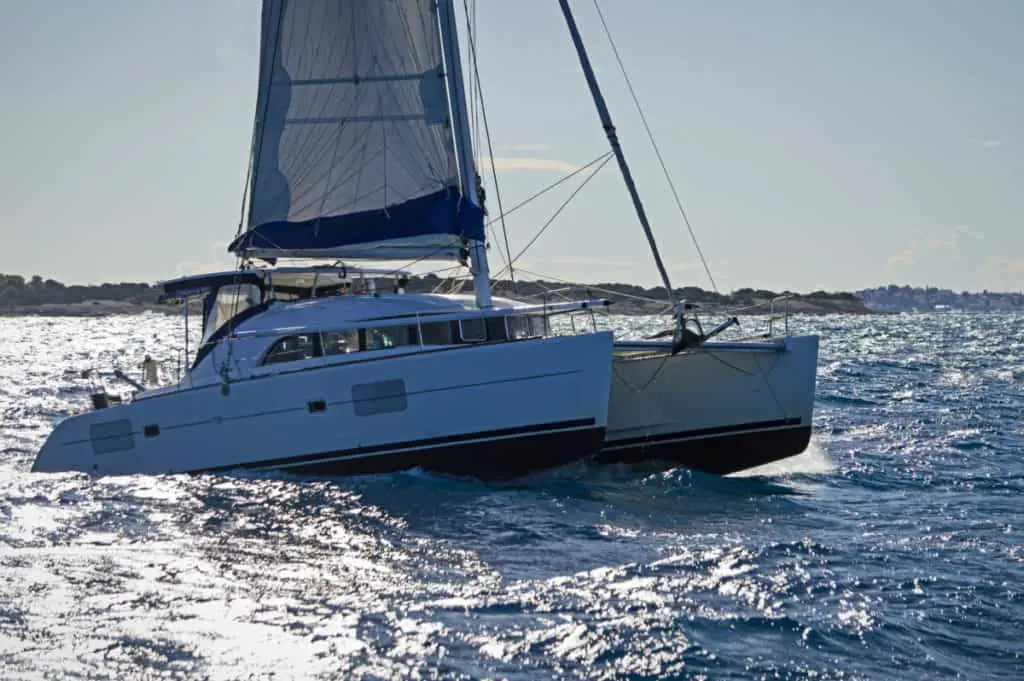
A catamaran is a boat with two hulls (a trimaran has three) connected by a bridge deck. Catamarans usually offer more space than both monohulls and trimarans of the same length. The catamaran is usually somewhat slower than a trimaran but faster than a monohull. They are usually made of fiberglass or carbon fiber.
Catamarans come in all shapes and sizes. You can find straightforward sailing catamarans, perfect for those who are only starting their sailing journey. Larger sailing catamarans have become extremely popular for long-distance sailing.
There are also power catamarans, they have huge diesel-powered engines (sometimes electric) and no sails. Also called “power cats”, these boats can reach 30+kts.
Can a Trimaran Be Trailerable?
As discussed above, some trimarans are possible to put on a trailer and move to another sailing area or to be stored at home. This is usually not possible with catamarans but is sometimes possible with the trimarans that are fitted with foldable amas (the two outer “floats” or “hulls”).
Some trimarans can be trailerable, this is mainly due to the ability to drastically decrease the vessels beam, sometimes as much as 50%. This allows the trailer plus trimaran to be below the legal requirements of the road.
Final Thoughts
It has proven difficult to beat the trimaran in terms of speed. Through the ages, this type of vessel has proven to be immensely enjoyable in all kinds of sailing activities. These can range from sea adventures to waterborne relaxation in your free time.
Trimarans come in various types, foldable, for cruising or racing, etc. However, there is a common factor: many of the small ones are trailerable. This makes them easier to move than most other types of boats.
Owner of CatamaranFreedom.com. A minimalist that has lived in a caravan in Sweden, 35ft Monohull in the Bahamas, and right now in his self-built Van. He just started the next adventure, to circumnavigate the world on a Catamaran!
Leave a Reply Cancel reply
Your email address will not be published. Required fields are marked *
Save my name and email in this browser for the next time I comment.
Recent Posts
Must-Have Boat Gear for Catamaran Sailors!
Sailing is probably the most gear-intensive activity I've ever done; there are so many decisions to be made about what gear to buy now, for tomorrow, and what to definitely never buy. The gear on...
What Kind of Boat Is The Best Liveaboard? Trawler, Monohull, or ...?
Living in a boat can be a thrilling, once-in-a-lifetime experience; however, knowing how to choose the right vessel to sustain the lifestyle you want to achieve can be crucial in making the most out...

About Rapido
The idea behind building the world’s best ocean-cruising trimarans came from the team that has built more than 1,500 production trimarans globally. The world-acclaimed Morrelli & Melvin was then tasked with developing the design and engineering for Rapido to start building! Separately, for those who think our advanced lightweight construction techniques have other applications, Rapido Catamarans adds an exciting new dimension to the fleet.

Latest News
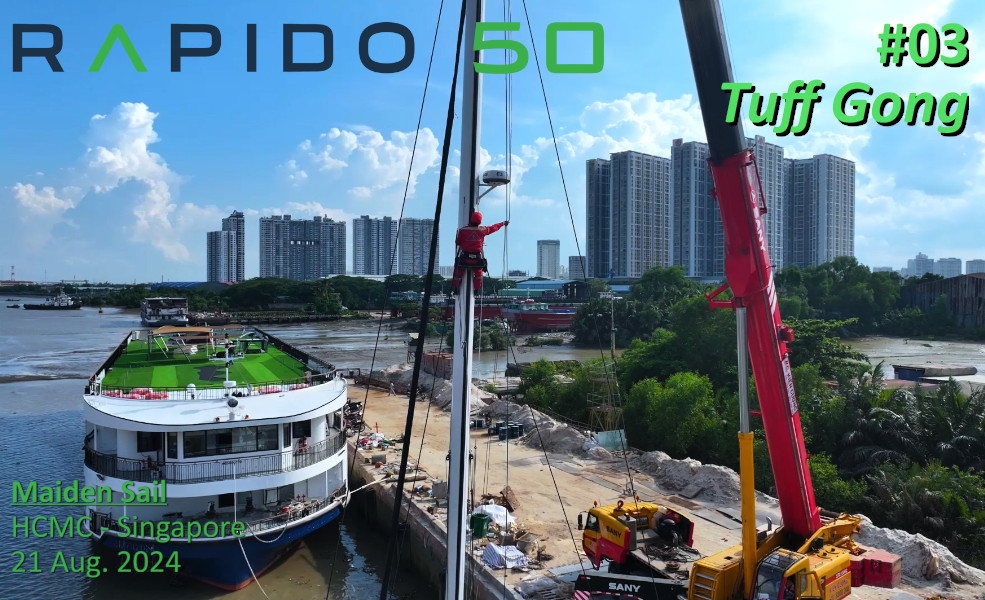
September 08, 2024
Video: Launch of Rapido 50 #03, Tuff Gong

August 22, 2024
Rapido Trimarans Statement regarding issues raised in Sailing La Va...
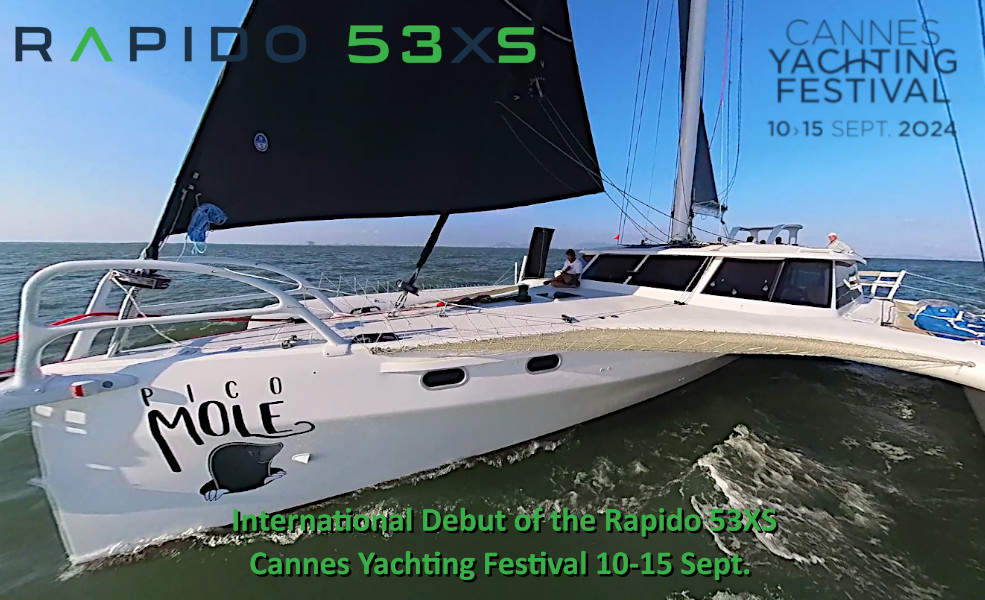
August 21, 2024
Cannes Yachting Festival 2024: International Debut of the Rapido 53XS!
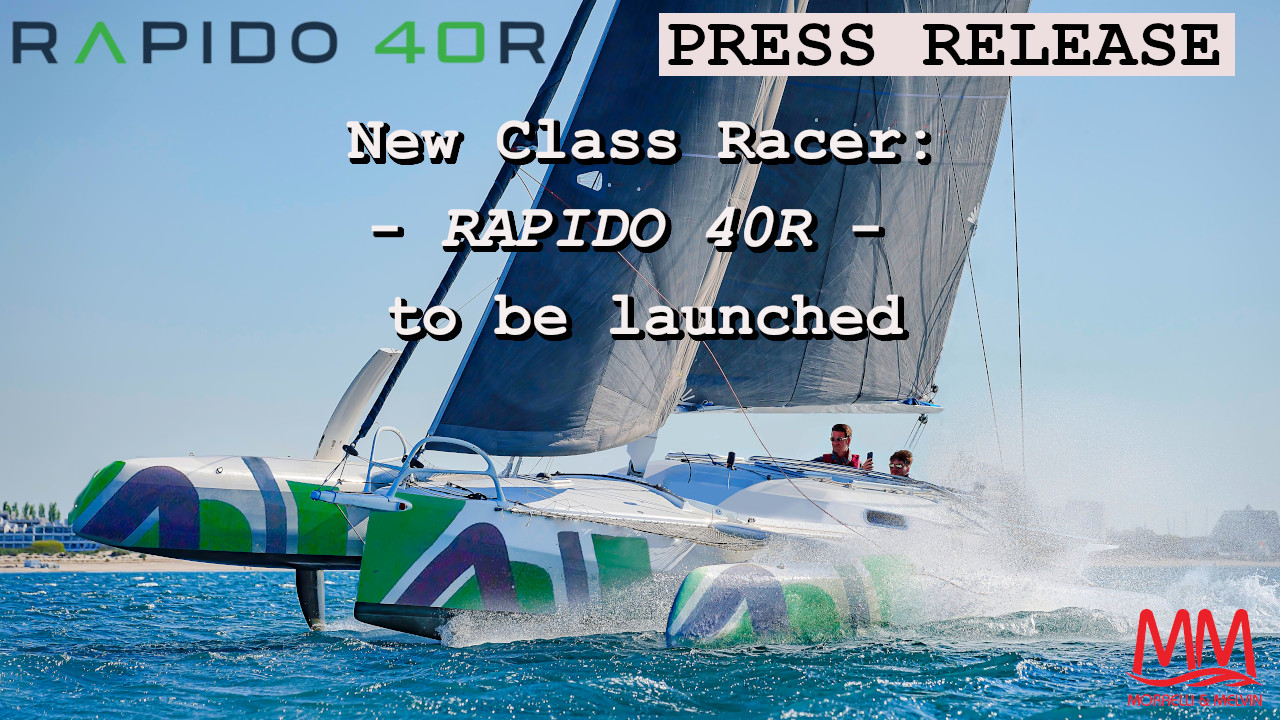
August 17, 2024
Press Release! New Class Racer, Rapido 40R to be launched. Special ...
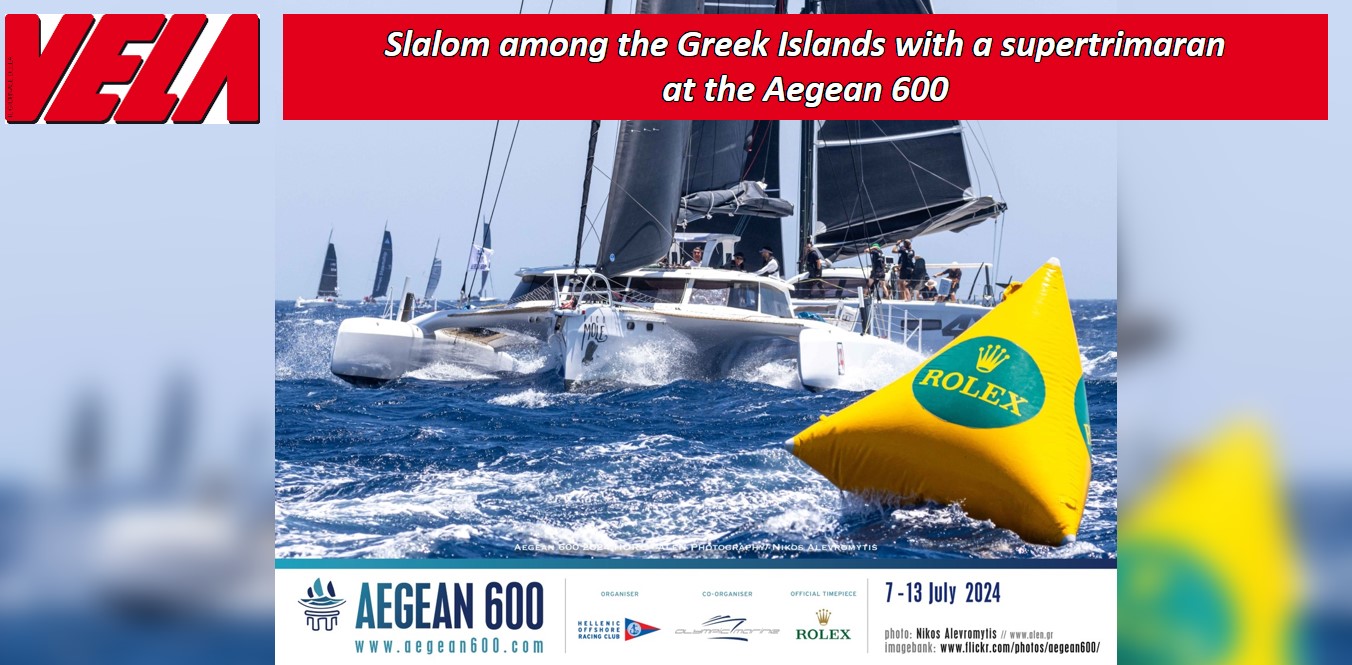
July 29, 2024
Slalom among the Greek islands with a supertrimaran at the Aegean 6...
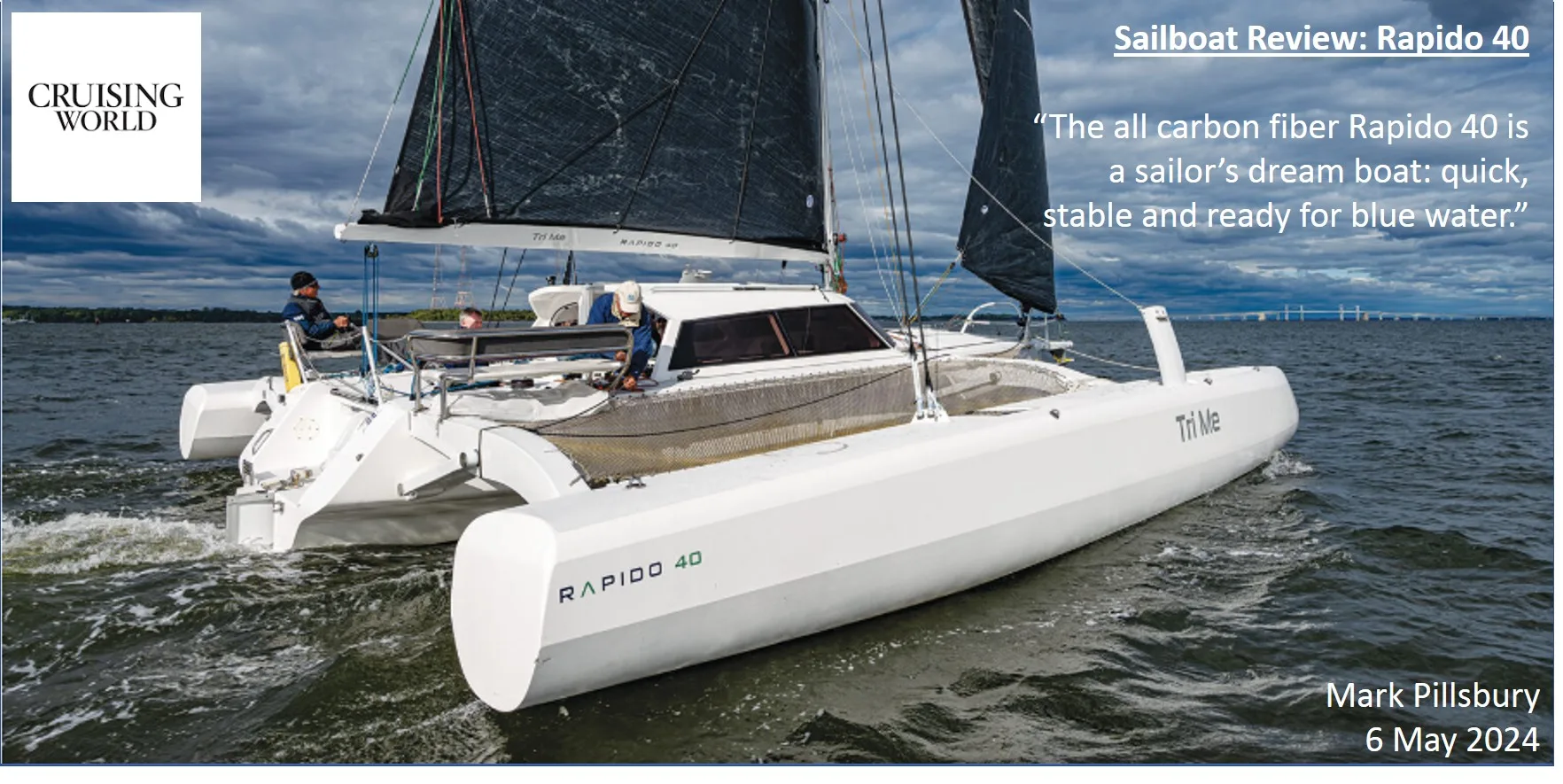
May 07, 2024
Cruising World reviews Rapido 40, a sailor’s dream boat
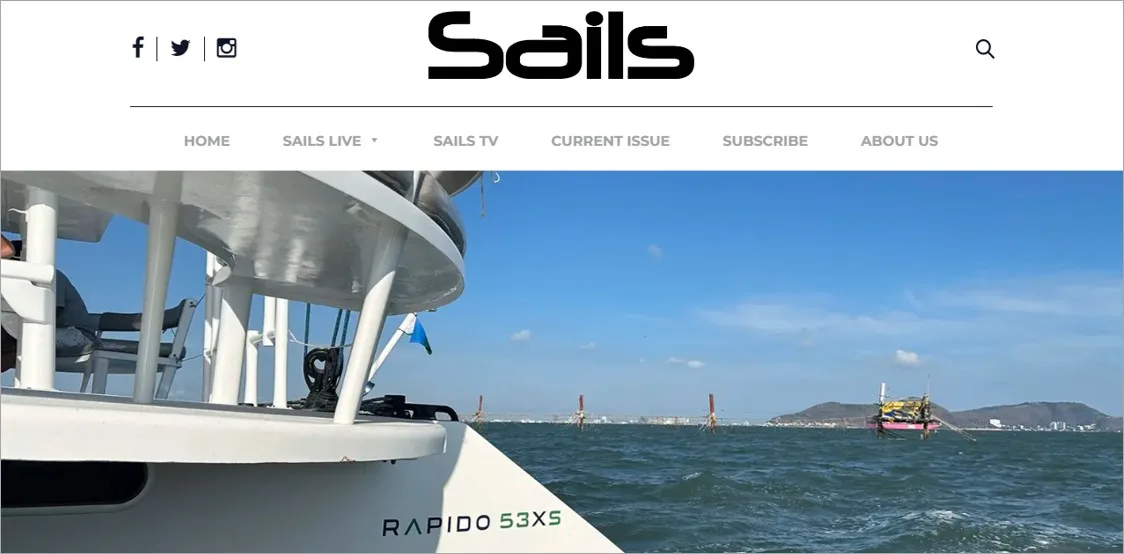
Rapido host much anticipated launch of first Rapido 53XS, Sails Mag...
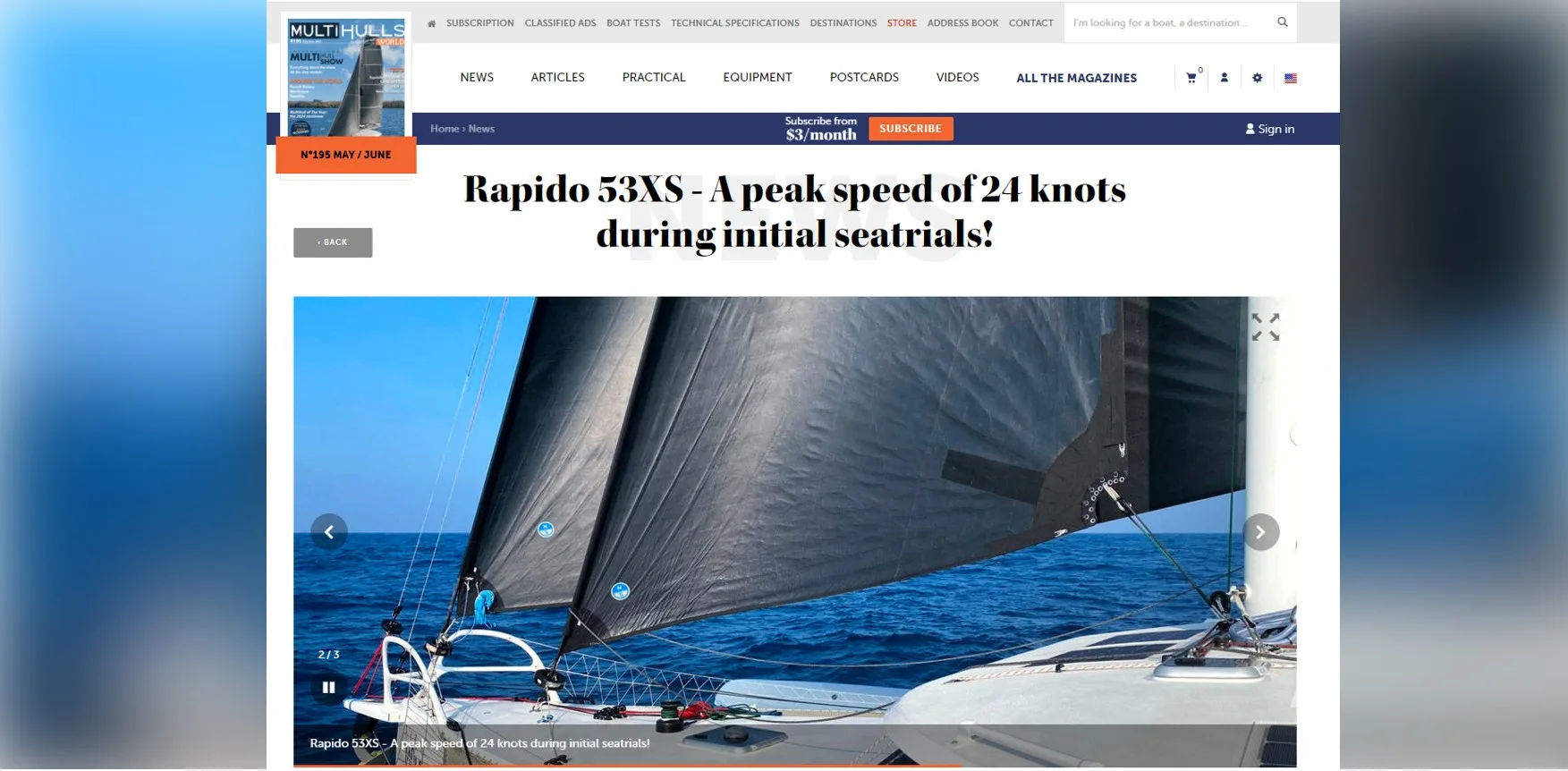

Rapido 53XS – A peak speed of 24 knots during initial sea trials!, ...
Discover rapido.
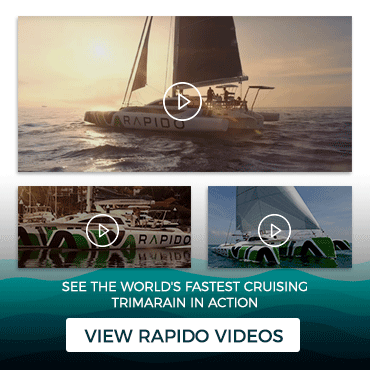
Yachting World
- Digital Edition

Neel 52 trimaran review
- Rupert Holmes
- December 22, 2023
Neel broke ground with its cruising trimarans a decade ago. So what’s changed with its new 50+ footer, the Neel 52?

Product Overview
Price as reviewed:.
We’re beating out of the approach channel to La Rochelle in 8-10 knots of true wind, with some tacks as short as 90 seconds. The yacht is tacking cleanly and accelerating willingly afterwards, underlining how manoeuvrable it can be in skilled hands. Yet this isn’t a lightweight monohull – it’s a 52ft semi flybridge multihull weighing more than 13 tonnes, the Neel 52.
The first generation of Neel trimarans, including the Neel 51 launched in 2017, set a new standard in combining handling that echoes that of a monohull with accommodation of a scale that can only be found on a multihull. The concept of the Neel 52 remains the same, using the hulls of a fast racing trimaran with narrow waterline beam, as a platform for expansive four- to six-cabin accommodation.
On paper there’s no significant difference in the key dimensions of each boat, but that conceals a number of important changes. An example for this market is a much improved owners’ cabin which now occupies part of the bridgedeck and can also include the entire starboard ama.
There’s also a big difference in how the new boat handles. Offshore racing multihulls are designed to optimise straight line speed, but that’s rarely the key priority for cruising yachts. As a result the shape of the main hulls and amas of this new Lombard design are very different to those of the Joubert-Nivel-designed Neel 51 it replaces (42 built).
In particular the forward sections have a very shallow forefoot compared to the old model, where maximum waterline length was a key priority. The change improves manoeuvrability and is an important factor behind the ease with which our boat tacked in the conditions we experienced for our test. The Neel 52 is also lighter, with improved balance thanks to a mast (and engine room) further aft and a larger jib.

Most sail handling operations, except using spinnakers and furling the headsails, can be carried out single-handedly from the helm station. Photo: Rupert Holmes
On the helm
Close-hauled in more open water, with the true breeze still predominately between 8-10 knots, we consistently made just over seven knots of boat speed at a true wind angle of 60°-65°. In these conditions there’s very little heel – just enough for the windward ama to skim above the water and markedly reduce wetted surface area.
Steering is via Dyneema cables, which gives a more direct response than many alternatives, though the boat’s heavier on the helm than a well set up monohull, with a less precise feel. Nevertheless it’s still good by the standards of many cruising catamarans.
The standard Neel 52 sail plan includes a square top mainsail, slightly overlapping headsail of around 120% and staysail. Our test boat also had a very flexible 150m2 furling gennaker that can be used for reaching in 10 knots of true wind or less and broad-reaching in winds well above 20 knots. Neel also offers a larger asymmetric spinnaker as an option, as well as a marginally taller carbon rig with higher-spec Hydranet sails.
All lines, except spinnaker sheets and furling lines, are led to three electric winches at the helm station. Separate luff and leech pennants for all three mainsail reefs help tame the sail quickly. There is, however, lots of rope in this area and insufficient rope bins to handle it.

The flexible gennaker on our test boat can be used for reaching in up to 10 knots of wind and at 140° TWA in well over 20 knots
Downwind and reaching sails sheet to the back of the amas, while genoa and staysail furling lines are led to the aft end of the starboard ama. This arrangement for the furling lines greatly reduces friction compared to the convoluted route they would have to take to lead to the helm station, but means furling these sails isn’t an easy single-person operation.
With the true wind building to 10-11 knots and puffs to 13 we consistently made speeds of around 9 knots, with occasional bursts just into double figures when reaching at 110°-120° TWA, with the gennaker and staysail set. This was easy sailing at speeds that will quickly gobble up the miles when on passage.
Visibility from the Neel 52 helm station is excellent on port tack, but there’s a big blind spot on starboard – you need to descend four steps to see under the jib or gennaker. A semi flybridge above the hard top, with space for up to eight people, includes generous sunbeds. This is right next to the helm/winch station, so communication between the two is easy and, unlike many multihulls, it doesn’t feel as though the helmsman is isolated from everyone else on board.
You have to be sure guests are sitting before tacks and gybes, when hoisting and dousing the mainsail, and when reefing on port tack. There’s a bimini for sunshade over the helm area, with a clear overhead panel for sail trim, but no provision for sun protection over the flybridge area, though the hardtop over the main aft cockpit gives plenty of shade.
A key selling point for Neel is offering a very refreshing change to the familiar layouts of cruising multihulls of similar length, and the Neel 52’s arrangement feels generally bright, welcoming and innovative.

The saloon adjoins the cockpit, however you need to stoop to see out of forward windows. Master cabin is to starboard but you need to draw blinds for privacy
Neel 52 – bridgedeck cabin
The older Neel 51 benefitted from Neel’s trademark bridgedeck level cabin, which gives a fantastic view out almost all round the boat when you wake up. This comes at the expense of some privacy, though, which is largely solved by closing the window blinds in the bulkhead that separates the cabin from the saloon. But this space was small compared to typical catamarans owners’ cabins.
Owners with guests will still need to close the blinds on the main bridgedeck cabin on the Neel 52, but this now links to the whole of the starboard ama. This is a private area with a desk/dressing table and a generous amount of stowage in hanging and shelved lockers. Ventilation is provided by several overhead hatches and there’s a long hull window above the desk which provides plenty of natural light.
The mid part of the owner’s ama has a heads with a separate shower stall, while further forward is an additional space that was left fairly open in our test boat, with the exception of a washer/dryer. This area has obvious potential for much more stowage, or even a workbench.

Large and well appointed galley.
The aft cockpit under the hardtop is relatively small, but this doesn’t feel important since this space fully opens up onto an expansive saloon, with the interior and exterior tables together forming a dining table that can be extended almost seamlessly to just over 3m in length.
Ahead of the saloon area is a large navstation with a double seat and a good view forward, to port and aft. However, the bridgedeck owner’s cabin creates a large blind spot on the starboard quarter and there is no hatch above to view the mainsail.
All layout options have a large and well equipped galley forward on the starboard side of the saloon. There’s acres of worktop space, a four-burner gas hob plus oven, large refrigeration and freezer capacity, plus a slimline dishwasher. Stowage is in 17 lockers both under the counter and at eye level. The saloon has two opening panels in the front windscreen for natural ventilation, plus a small opening hatch over the cooker.
In four-cabin boats steps lead down to a double cabin in the port ama, with a large double berth aft, above which is a long hull window that gives a great view out. Stowage here is primarily in a small hanging locker, plus empty space under the berth that can be used for easy access to kit bags. Forward of this are heads and shower compartments mirroring those of the starboard ama, and further forward a space similar to that with the washing machine on the starboard side.

Bridgedeck level owner’s cabin.
Alternatively the port ama can be fitted out as two doubles that share a central head/shower compartment. This option is also available in the starboard ama for six-cabin charter specification boats. These also gain additional saloon and dining space on the bridgedeck as there’s no owner’s cabin at that level.
Seven steps at the front of the saloon descend into a further double cabin in the centre of the main hull, under the solid bridge deck. There’s plenty of space, but natural light and ventilation are restricted, with the former coming solely from the two escape hatches. There’s stowage plus a heads compartment (without shower) shared with a forward cabin at the front of the main hull.
On the test Neel 52 this is fitted out as a Pullman-style cabin with bunkbeds. Crew cabins, each with a single berth and head/shower, can also be specified at the aft end of each ama.

Owner’s hull space in starboard ama
On the downside, some elements of the interior have hard edges in places that may not wear as well as rounded corners. And traditionalists won’t be impressed by the inside of lockers which have a similar feel to mass market home furniture.
Neel’s trademark full height technical area with engine and systems is restricted to the back of this model. Nevertheless, it remains a well laid out and useful space that will make maintenance and repair easier than on many yachts. Unlike cruising catamarans, Neels have only a single engine in the main hull, so a bow thruster is fitted as standard. A stern thruster is offered as an option that can make Mediterranean-style mooring a lot easier.
Deck stowage includes large lockers that can accommodate sails, fenders and watersports toys, while the tender rests on purpose made chocks at the aft end of the main hull. It’s lifted using a line from the end of the boom – a simple arrangement that avoids the weight, complication and cost of davits. Access to the water is from the extended bathing platforms on the aft end of each ama and the transom of the main hull.
Our test Neel 52 was set up with just under 2kW of solar panels on the coachroof. Neel says this is almost enough for complete autonomy while cruising when combined with the boat’s lithium iron phosphate battery bank, though as standard 625Ah of 12V AGM batteries are fitted.
If you enjoyed this….
Yachting World is the world’s leading magazine for bluewater cruisers and offshore sailors. Every month we have inspirational adventures and practical features to help you realise your sailing dreams. Build your knowledge with a subscription delivered to your door. See our latest offers and save at least 30% off the cover price.
There’s much to like about this boat for anyone who needs the accommodation volume offered, or is seduced by the appeal of Manhattan-style loft living. The Neel 52 also offers a big advantage over its predecessor thanks to the reconfigured owner’s suite with immensely more space. Speeds under sail are unlikely to differ noticeably to the 51, which already had potential for very quick passages when reaching, although upwind and downwind VMG for both models is less impressive, other than downwind in a blow. However, the way the new boat behaves under sail gives it a feel closer to that of a cruising monohull. More importantly for this part of the market, the 52 is easy to handle, with few operations requiring more than one person on deck. These factors, combined with the various layout options, boost this yacht’s appeal and by the time the prototype had been in commission for three weeks, delivery schedules were already stretching into early 2026, with 26 boats sold.
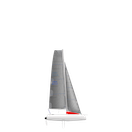
Folding System
Legendary ability, unbeatable reliability.
Folding and unfolding a Corsair trimaran takes only a minute. With just 4 bolts to remove, it is easily managed by one person, and is normally done while afloat. Simply raise (to fold) or press down (to unfold) the inboard end of one cross beam. It can be done from the safety of the cockpit and only a little force is needed due to the folding system’s carefully balanced geometry, and the movement of the floats being mostly horizontal.
The solid aluminium folding struts have absolute control over the folding motion and prevent flexing or racking. A stainless steel bolt on the inboard end of each beam secures the floats for sailing. Crucially, wingnets remain attached during the folding process – their frictionless fixing allows them to tension themselves appropriately through the folding process. The system is so simple and balanced that Corsair trimarans can even be folded while motoring.
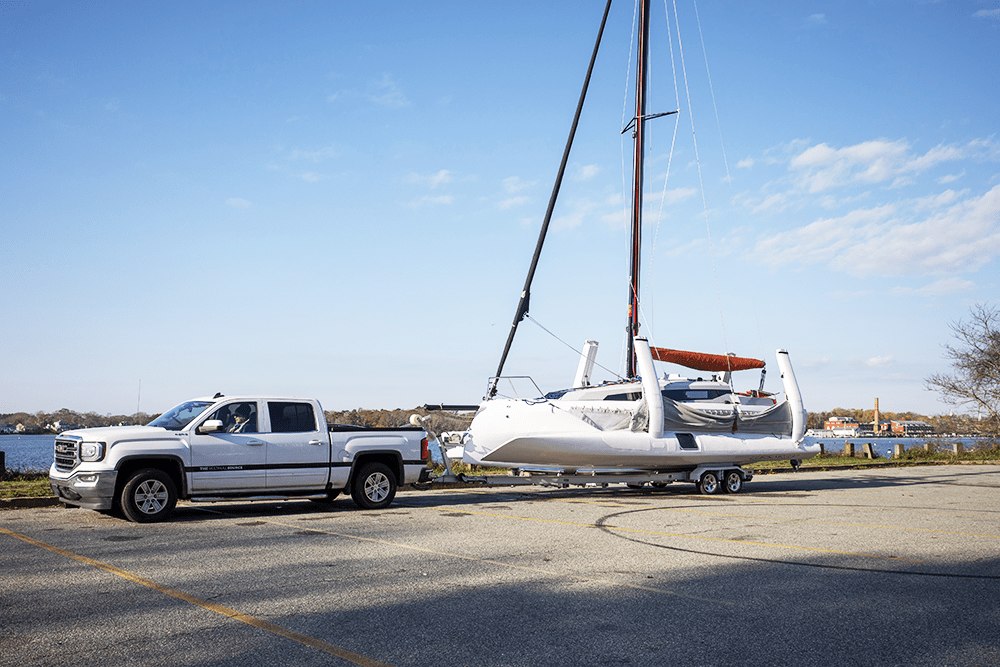
TRAILERING ACROSS CONTINENTS
Corsair Marine trimarans are especially weight-conscious, and sit low on their trailers meaning they have excellent trailering characteristics. They are equally easy to launch, giving you more time on the water, and the ability to expore many more remote cruising grounds or participate in regattas far from home. Some Corsair trimaran models go from trailer to water in 25 minutes, and with practice even the largest boat models can be done in 40 minutes.

Corsair 880 Trimaran | 2022 Boat Review by Multihulls World
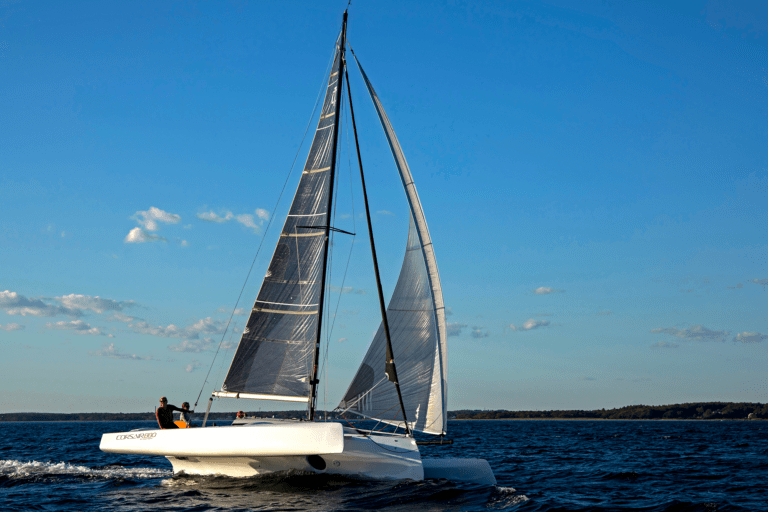
Corsair 880 – Drive Out, Fold Out, Thrill Out, Chill Out
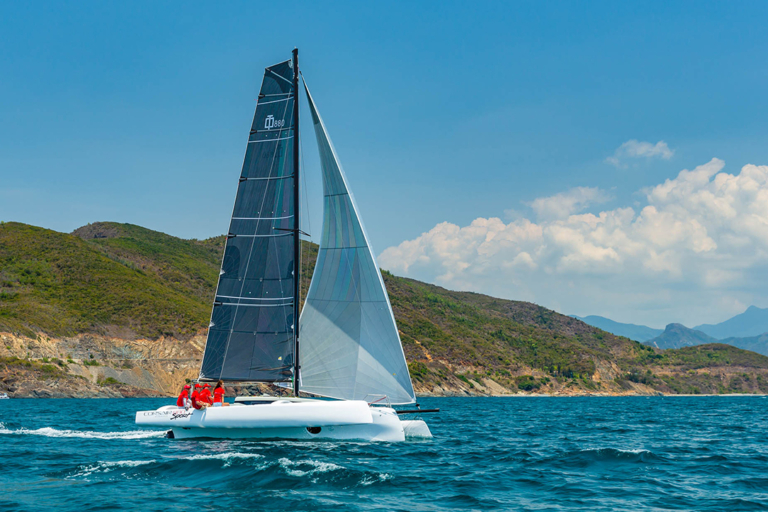
Australian Debut of the Corsair 880 at the Sydney International Boat Show
- Folding Corsair Trimarans: Legendary Ability, Unbeatable Reliability
- 5 Reasons Why The Corsair 760 Trimaran Won Multihull Of The Year
- Corsair Range Brochure
- Corsair Community
- Find A Dealer

Tel +84 28 3873 3630
Sales Enquiry:
Customer Service Enquiry:
© 2024 Corsair Marine International. Alls rights reserved.
Privacy Policy
- Dragonfly Service
- Dragonfly 1200
- Dragonfly 920
- Factory Tour
- Backstage Videos
- Dragonfly Sail Guide
- Try before buy
- Dragonfly-Training & More
- Newsletter Archive
- Clubs & Associations
- Customer stories
- Merchandise
- Privacy Policy
- General Terms of Sale
Dragonfly 40
The all-new Dragonfly 40 is a cutting edge design with focus on easy handling and shorthanded sailing. Spacious cockpit and a stylish, modern interior. Setting new standards for comfortable and safe family offshore sailing. World Premiere boot 2020 Düsseldorf.
Dragonfly 25
The all-NEW Dragonfly 25 is a high-performance trailer-sailer, easy handling for camping and racing sailors looking for an exhilarating lightweight trimaran which retains comfortable accommodation for weekend cruising with family and friends
Dragonfly 28
The Dragonfly 28 sets new standards for the possibilities of a sailing boat. The perfect boat does not exist - but the Dragonfly 28 is very close to this ideal. New facelift design for all Dragonfly 28 models. The Dragonfly 28 comes in both a Touring and Sport version, and, introducing 2016 the new Dragonfly 28 Performance version
Dragonfly 32 Evolution
Discover the evolution of a popular model. Introducing high volume wave piercing floats for fast and relaxed sailing. Quality combined with performance secures an outstanding experience.
45 years of Trimarans
Quorning Boats offers an excellent range of our prize winning Dragonfly trimarans.
From ultimate freedom in versatility and performance to ocean crossing cruising, safety and comfort, it's your freedom of choice...
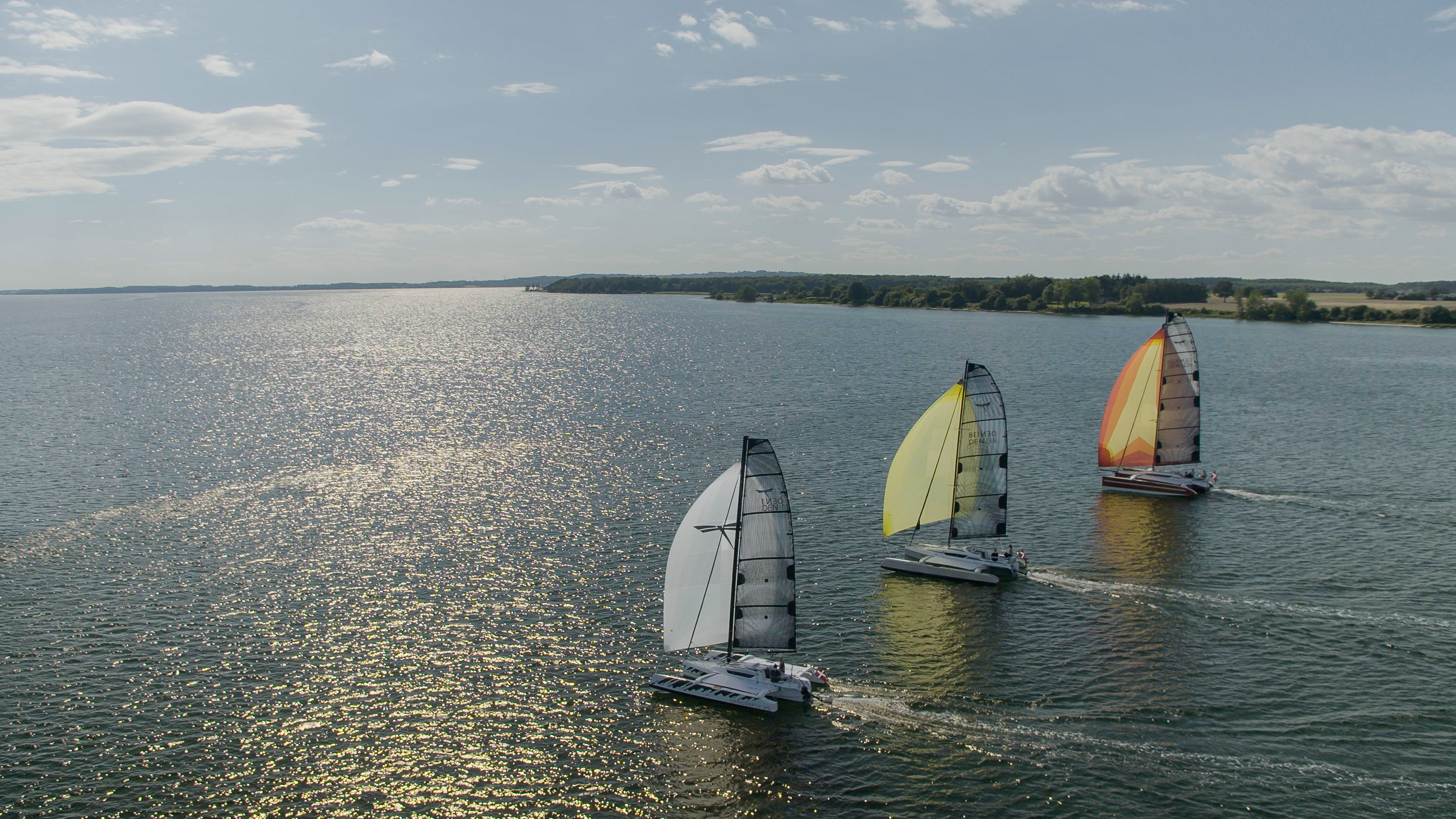
Southampton Boat Show
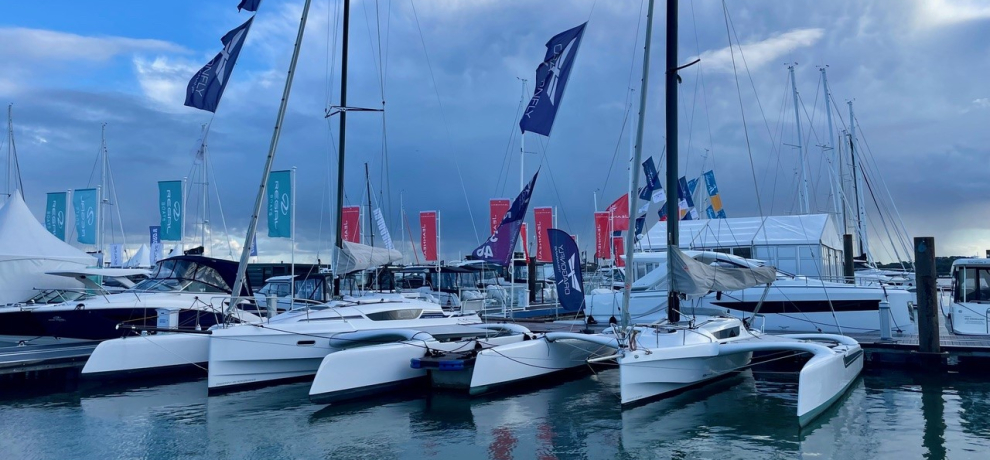
From 13-22 September 2024, our dealers from Multihull...
Newport Boat Show
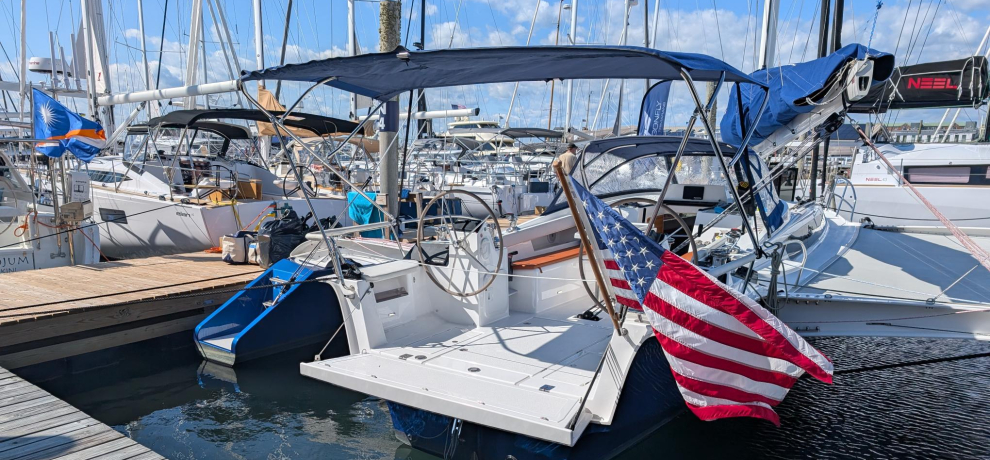
From 12-15 September 2024, our dealers from Windcraft...
Cannes Yachting Festival
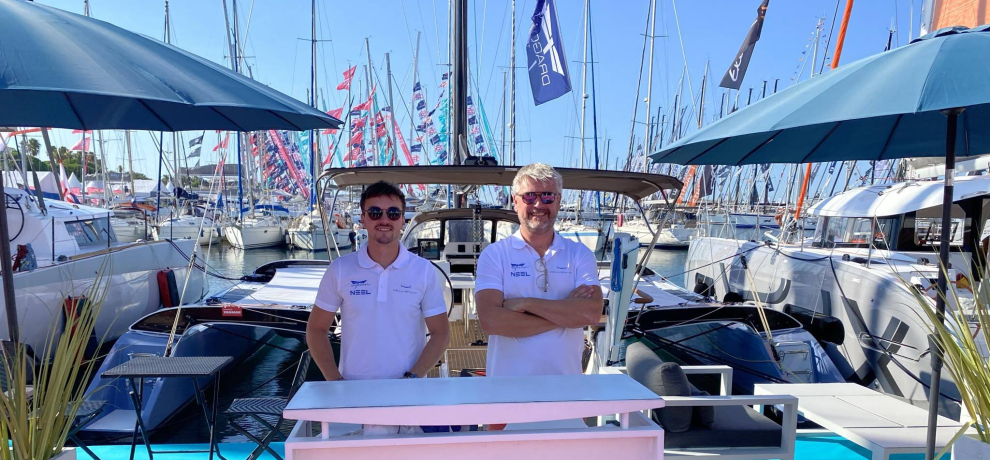
From 10-15 September 2024, our dealers from...
NEW Dragonfly 36
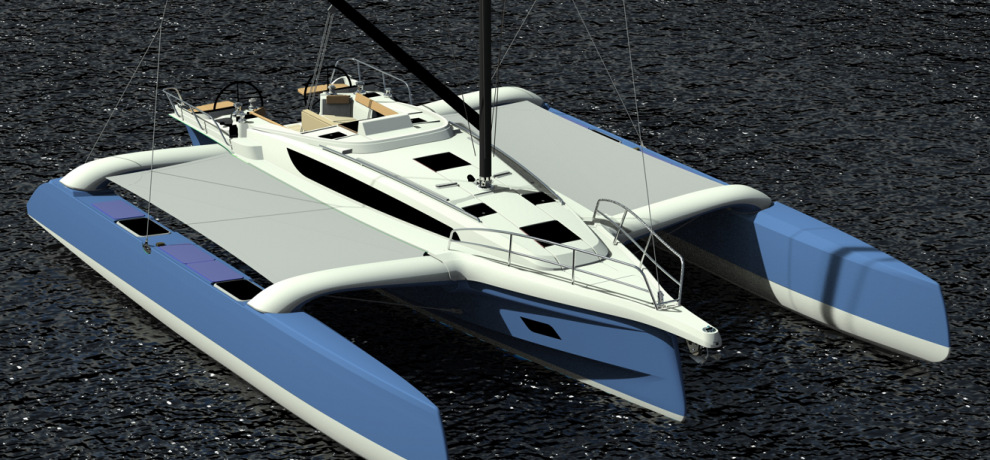
After 2.5 years development, we are proud to introduce our...
Dragonfly Days 2024
Join us as we wrap up an unforgettable three days of sailing,...
Dragonfly Days 2024 - Day 3
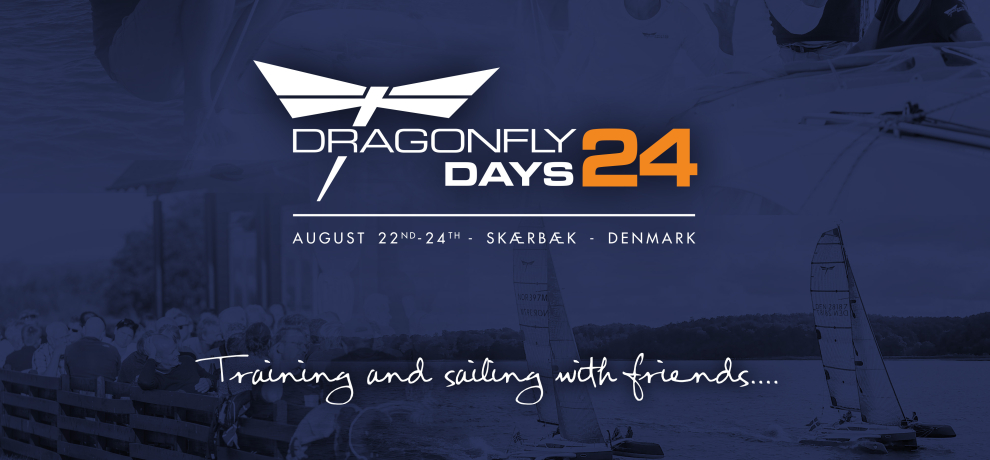
The 3rd and last day of the owner's event Dragonfly Days 2024...
Dragonfly newsletter

Find a dealer
Find your local dealer
Quorning Boats ApS
Skærbækvej 101 7000 Fredericia Denmark
+45 7556 2626
VAT No DK 18 88 83 78
Dragonfly 32
Dragonfly 36
- Previous models
Quick links

- AROUND THE SAILING WORLD
- BOAT OF THE YEAR
- Email Newsletters
- America’s Cup
- St. Petersburg
- Caribbean Championship
- Boating Safety
- Ultimate Boat Giveaway

The Caribbean’s Hot One-Design Fleet
- By Dave Reed
- August 13, 2024
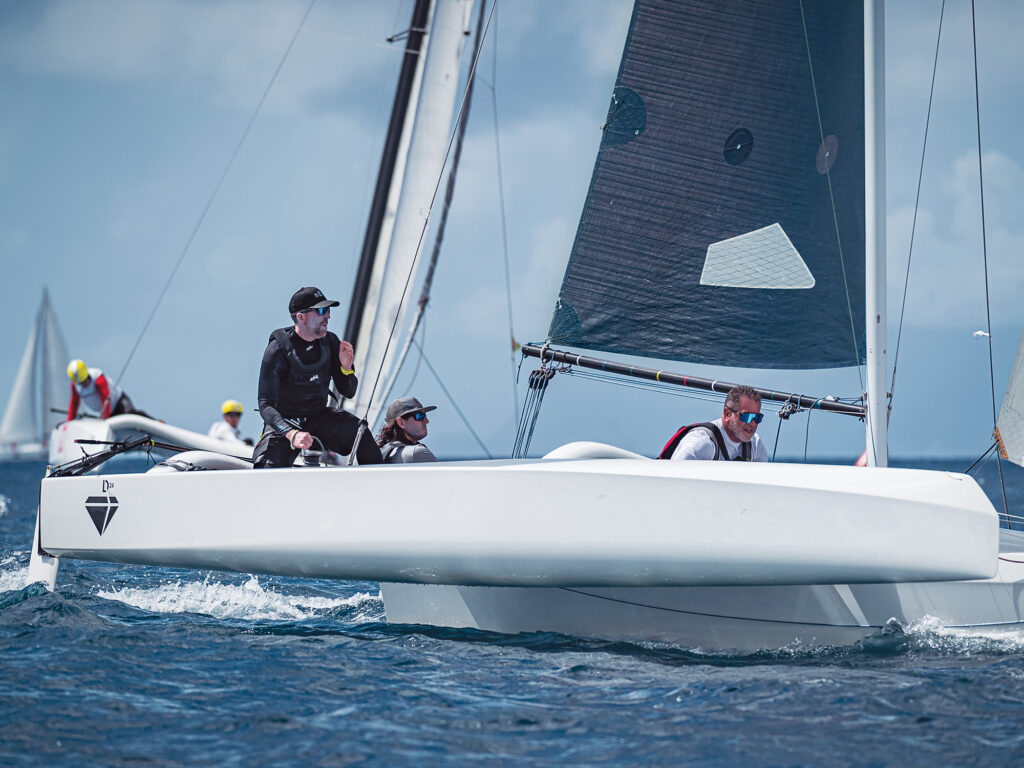
I’d love to look around and enjoy the scenery, but I can’t take my eyes off the leeward bow that’s slicing through the Caribbean at 20 knots. I’d been advised earlier: The fine line between full-tilt and pitchpole is somewhere right around the chine on the wave-piercing bow. The warning also came with a caveat: “The faster we go, the safer we go.”
That’s the wisdom of Pierre Altiere, a master of the Diam 24 trimaran, with whom I’ve scored a ride for the St. Maarten Heineken Regatta. The point of the exercise is to experience firsthand the hottest one-design fleet in the Caribbean. Altiere’s boat is named Cry Baby , which I may eventually come to understand, but right here, right now, all I can think about is the gust breathing down my neck.
I ease the gennaker sheet in my hand and watch the bow submerge. Oh, sh-t, I think. Here we go. I’ve seen pictures of Diams tumbleweeding, but the bow porpoises. A ball of seawater smacks the forward beam and explodes into a cloud of sunlight sparkles and foam.
With a jab of the tiller bar, Altiere redirects the boat and reloads the sails. The daggerboard hums a few octaves higher as we skim across the shallow blue flats of Phillipsburg Bay. It’s thrilling and a little terrifying, and thankfully, we’re just getting started.
It’s an early March morning on St. Maarten’s Kim Sha Beach, on the bustling Dutch coast where six identical 24-foot trimarans sit under palm trees, surrounded by umbrellas, chaise lounges and rental kayaks. Four other Diams swing on their anchors a doggie-paddle’s distance from the beach. This is the homegrown Diam 24 One Design fleet, which in a few short years has multiplied from three to 10. Soon enough, Altiere promises, if his Diam dream scheme pans out, we will be looking at as many as 20.
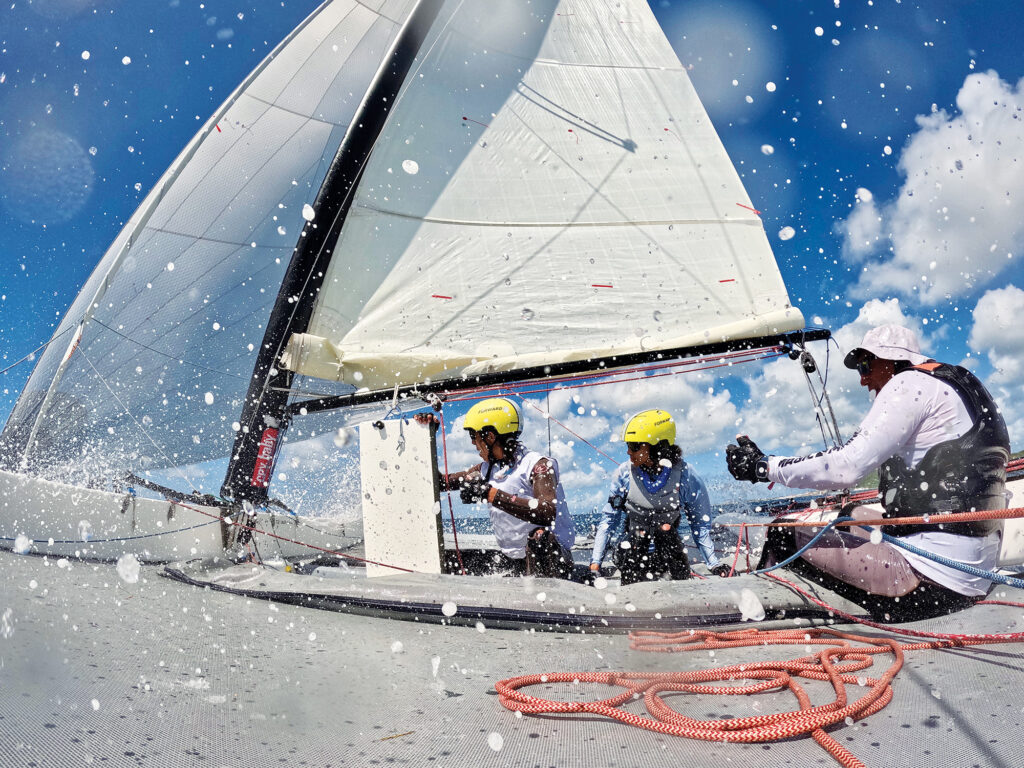
Altiere, I’m told, is the spark, the one who started it all, and judging by the parade of sailors seeking him out for advice, parts, assistance and you name it, it’s obvious that not much happens without Altiere. As we rig our own boat, interrupted by phone calls and favors, he gives me a quick lowdown on the Diam, which was created by Vianney Ancelin, a French multihull sailor and boatbuilder. Ancelin’s vision was a recreational multihull that average sailors could handle—sporty but not lethal, high-tech but not overpriced. That was the idea before the Tour de France a Voile—a multistage regatta—adopted the Diam as its official one-design. Pro race teams with million-dollar budgets promptly priced amateurs out the class, and then the pandemic put a fork in the Tour. The builder, ADH Inotec, stopped production at just north of 100 boats. With the Tour on hold, however, there was suddenly a pile of secondhand race-ready boats, many with containers full of unused spares, most fetching $20,000 to $30,000.
Enter Altiere, the tall, jovial and hard-charging Frenchman who taught at a sailing school as a young man and then opened his own in Tahiti before landing in St. Maarten, where he operates a thriving private catamaran charter business. As a top-level F18 catamaran sailor not far back in the day, a friend once invited him to race a Diam in France. He knew little to nothing about the boat at the time. “As an F18 sailor, I knew what I was doing,” he says. “I hadn’t raced [in Brittany] in 20 years, but we somehow made it onto the podium, everyone applauded us, and I enjoyed it so much that the next day we started talking about becoming an agent for North America.”
He did, but the big continent was impossible to crack, so he pivoted to a better plan: bring potential buyers to the boat and give them a taste. Step 1: Establish a Diam base at home in St. Maarten and show off the boats. Step 2: Enter them into the region’s big-draw regattas: the Heineken and Les Voiles de St. Barth.
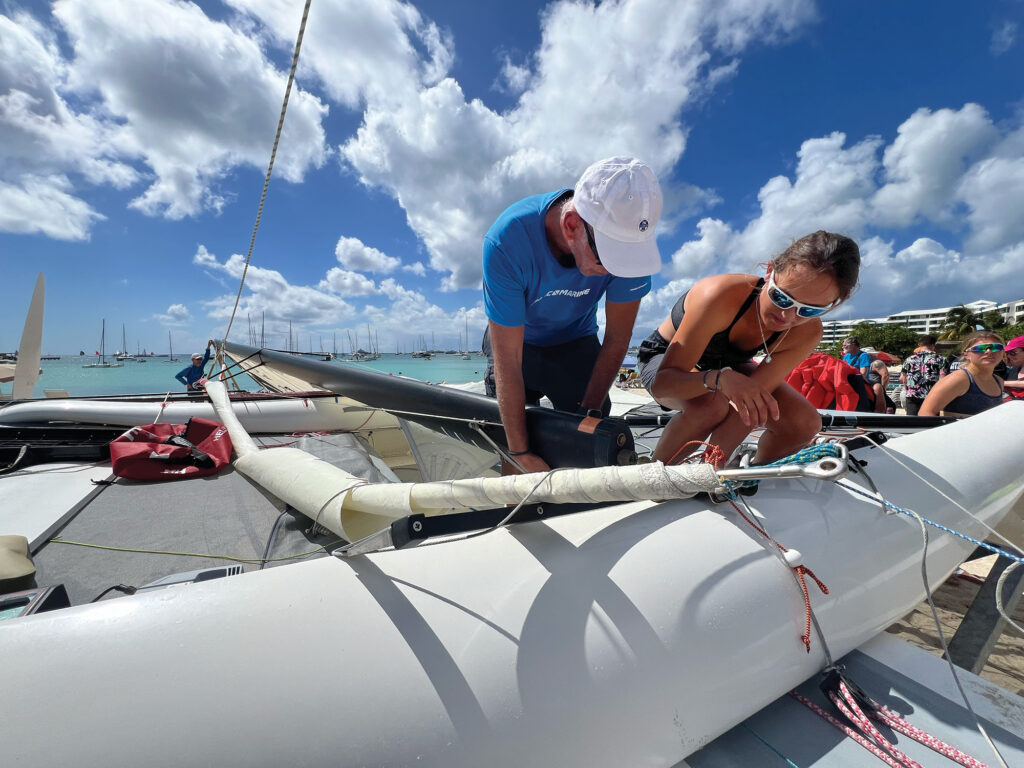
“There’s nothing better than an easy flight to St. Maarten, throwing your bag in the hotel, and jumping onto a Diam that same day,” Altiere says. “Just like me, I was offered a chance, I had a great experience, and right after that, I bought a boat. That’s the easy-regatta concept here: Fly in, race, celebrate, fly out.”
And that’s how “sort-of” New Yorker Adam Holmes and his buddies Ben Ferraro and Bob Young were lured to Kim Sha in late March for the Heineken Regatta. Holmes, an advertising executive and Long Island-based racing sailor, had heard about the Diam fleet through a friend in St. Maarten, who connected him with Altiere, who had one charter boat available for the Heineken Regatta.
How much for a good time?
Five-grand—tops—according to Holmes’ mental math, and that was with a top-shelf condo, on the water, for a week. Altiere’s charter fee, which included four days of racing and two days of practice, was only $3,700—worth every penny on the speed-to-dollar scale. For months, the three of them exchanged Diam sailing videos that they found online. “That was like the start of the adrenaline rush,” Young says, and when they jumped on board for their first figure-it-out-yourself session in St. Maarten, the real thing was a real rush.
“We didn’t get a very detailed briefing before our first sail,” Holmes says. “At one point on the first practice day, we were sending it at like 19 knots, and the hull was so far underwater. Bob had the kite strapped in hard and we were just flying…like really, really on the edge. The Diam guys following us in the RIB and yelling at us in French were freaking out because we hadn’t yet signed any paperwork.”
“At the time,” Ferraro adds with a laugh, “we had no idea we were on the edge—we didn’t know any better.”
But with a few more hours of practice and less than 30 minutes of one-on-one with Altiere, they were ready enough to throw themselves straight into the races. Ferraro was nominated to drive, Holmes got the back-breaking main trimmer’s spot, and Young took on the busy end at the front of the cockpit.
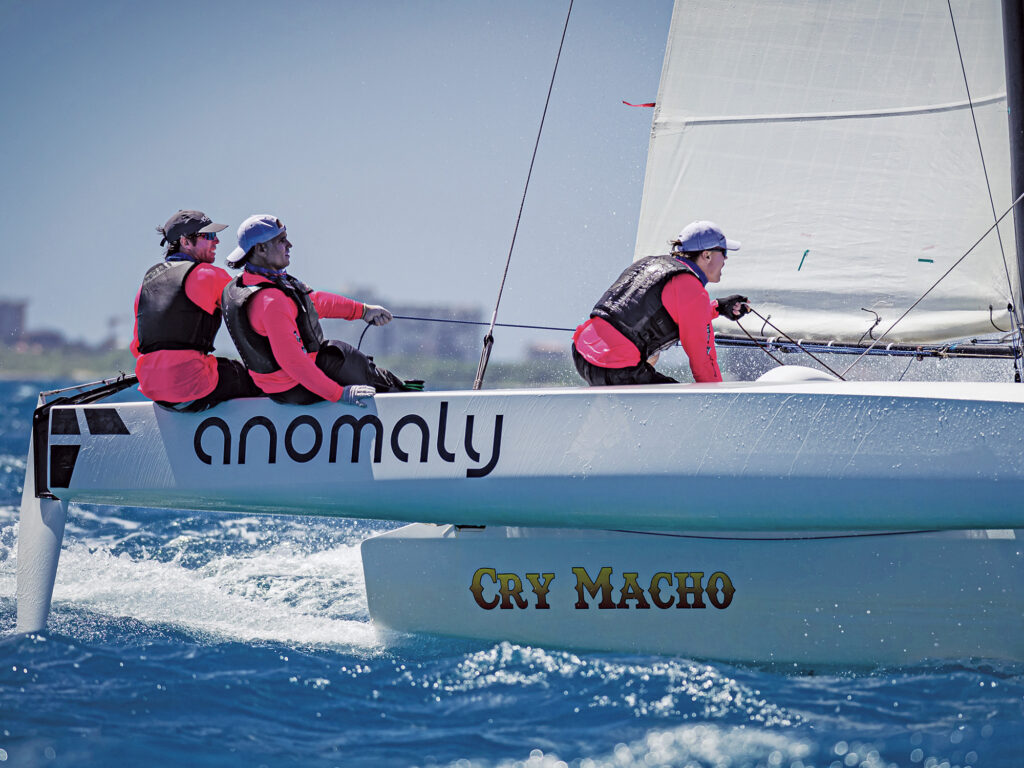
On the first morning, the breeze is up to 15 knots, and even though the start is in 90 minutes, the vibe on Kim Sha is bizarrely relaxed. Beach attendants rake the sand for the inbound tourists while sailors wander about in farmer-john wetsuits, surf trunks and rash guards, most of them conversing in fast-paced French and tinkering with their boats.
Among them is Erick Clement, one of the originals. He is a master of the Caribbean multihull racing scene and enjoying his retirement from F18 catamaran racing. Daily yoga, and healthy eating keep him young and in Diam-worthy shape.
“The speed is good and the boat is not complicated, but you have to get a feeling for it,” he tells me in his best broken English. “When everything is right, the steering is balanced perfectly, and you listen for the noise of the daggerboard—that helps you know when it is right.”
As a simple three-crew boat, the roles are straightforward. Whoever has the pleasure of helm also gets the traveler—the capsize preventer. The middle crew manhandles the insanely loaded mainsheet, trims the gennaker, and assists with dousing it. The forward crew is responsible for the self-tacking jib sheet, sail controls (outhaul, cunningham, mast rotator), gennaker hoisting and the daggerboard. Between calling tactics and jibing angles, housekeeping the trampoline, and watching for traffic, it’s an active boat for all involved, especially when big-breeze buoy racing in St. Maarten.
“All crew are super-important,” Clement adds. “If one is not playing the game, you can’t do anything. You have to have a good balance with each other.”
That will be a problem for us on Altiere’s Cry Baby because we are rotating new teammates every day. With us for the first day is a strapping young Frenchman named Corentin, who goes by Coco. He’s one of Altiere’s charter boat captains and has some Diam racing experience, which is good because we’re straight into the first start without a lick of practice. It’s a chaotic five minutes of weaving through rush-hour traffic: big custom raceboats, cruisers, bareboats and two 100-footers, all pinging the starting line.
The Diam will go from zero to 15 rapidly, but it’s not the kind of boat you can luff-and-hover on the start. Full speed is Altiere’s preferred approach, and with 45 seconds remaining in the opening sequence, he is stalking next to the committee boat, mentally calculating the layline and time to kill. But the other boats are stacking up at the starboard end, making what looks to be an impossible entry. But, hey, Altiere is the man and the defending champ. This is his domain. Who am I to doubt?
At 30 seconds, he booms, “OK. We go!”
And go we do, bearing away to full hum, straight toward the big catamaran committee boat. Just when it looks like he is going to pull off a high-speed barging start, Holmes and his crew tack in front of us and stuff the boat into irons—three sun-creamed deer in our headlights.
It’s either them or the committee boat, but Altiere pulls the hand break, and we coast to a near stop. The bow of our center hull disappears beneath the catamaran’s bridge deck, and the starboard bow just clears the cat’s starboard transom. I run forward and push off, and Altiere apologizes while cursing the New Yorkers for their erratic driving.
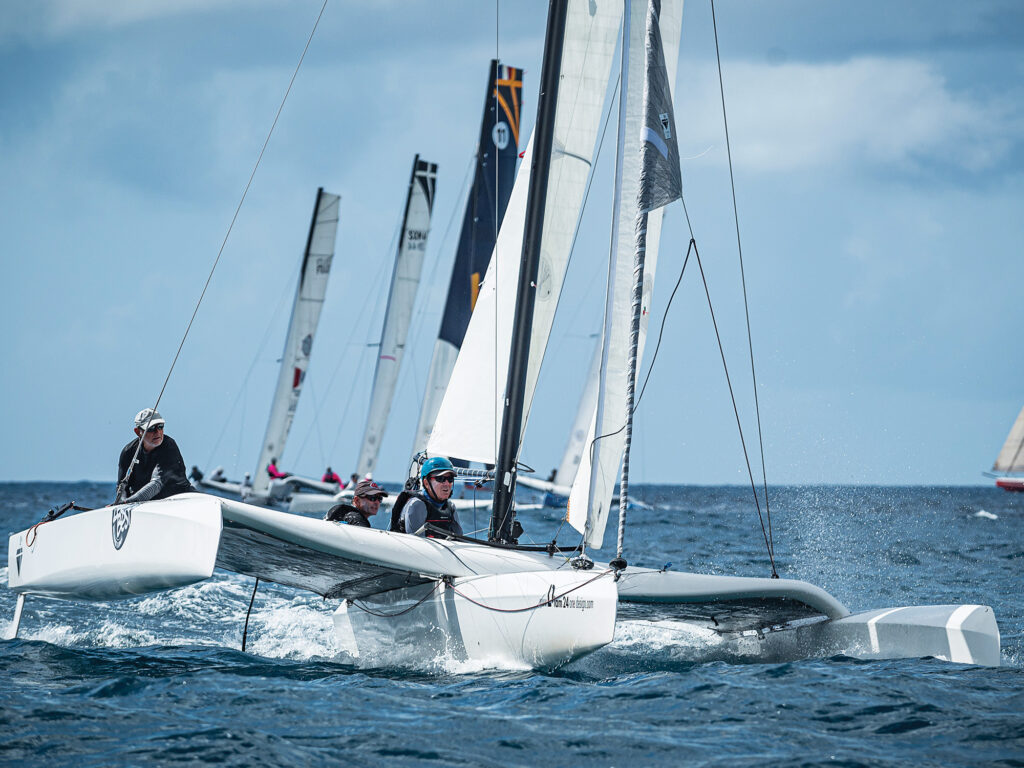
“I mean…it was our first race, and we were still trying to figure out how to tack the damn thing,” Young says. “That was a little nutty.”
“OK, let’s go,” Altiere shouts once again. More trim!” And with that, we’re chasing down the fleet. I pull the mainsheet as hard as I humanly can. The sail is board-flat and the telltales are streaming.
“More trim!” he shouts again. “We do it together.”
He reaches forward with his big right arm, grabs hold of the sheet with one hand, and together we grunt another 2 feet. The weather hull rises higher, and then the center hull breaks the surface. I’m staring at the line that Altiere had drawn on the bow with a Sharpie. That’s my fine-line guide for the week.
“More speed,” he says. “We will get them.”
I pull but get only another inch. He reaches in and gets another 6, finds his gear, and lets it rip.
The collective opinion on Kim Sha is that Altiere is the best sailor in the fleet, and I can see why. He effortlessly threads the trimaran around oncoming traffic, across big waves, and through giant puffs that pin other boats on their ear. He will dive to leeward of another boat and sail right through its lee. Downwind, he sits inside the center hull, hunched, with his hand behind him on the tiller bar, laser-focused. He senses every subtlety of the boat and knows what it will do before it does it. And more than once, when we sail into a lull and our speed drops, he puts his hand up in the air and says, “Bwaah…come on, wind, what is wrong with you?”
He’s seriously annoyed with the breeze for denying him his speed.
The first race is a windward/leeward blur, and we somehow manage a midfleet finish. Same for the others that follow, but our mishaps reflect our thrown-togetherness. We’re fast in a straight line thanks to Altiere’s skills, but every slip-up is a dozen boatlengths lost—and that’s no lie.
Back on Kim Sha, there’s a beach bar 10 feet from the boats. It’s got reggae, cold beer and cheeseburgers in paradise. The fellas from New York are happy to be back on the beach with their recovery juices in hand.
“That was kind of devastating,” Ferraro says. “We were miles behind on all the races, like it was not even close. We weren’t going to drink, but then all of sudden, we’re standing there with a drink in our hand and were like, ‘What just happened?’”
Young isn’t bothered at all about the results. He’s whipped, but it’s worth it: “All I remember was thinking, I’ve never gone that fast on a sailboat. I think our top speed was 20.7. The sound of the boat and that hum going at that speed was just like, holy sh-t. Let’s just hold on.”
With the wind forecast to peak into the mid-20s, the St. Maarten Heineken Regatta’s legendary around-the-island race is next on the to-do list. Big island, big breeze and it’ll be big-time fun, Altiere promises me when we meet at the beach and introduces me to Camille, another of his charter boat captains. She’s petite, and Altiere confesses he had miscalculated the wind forecast when lining up crew for the regatta.
“We will struggle a bit upwind because weight is very important,” he says, slapping a big hand on my shoulder and cracking a big smile. “But we will be very, very fast on the reaches.”
And he isn’t kidding.
To start our circumnavigation, the race committee dispatches us on a short upwind leg. Once we turn downwind and deploy the gennaker, we’ve got many miles of open-ocean high-speed tropical send. In these conditions, Altiere is in his element and sails right up to and past boats that got ahead of us on the upwind leg. Our top speed, according to my watch, is 22.9.
But every downhill has uphill, and way too soon we’re furling the gennaker, lashing it to the trampoline, rounding an orange tetrahedron, and pointing three bows into steep, wind-whipped waves.
“More trim!” is all I hear for the next hour, or “More speed!”
Each time, I pull with everything I’ve got, the rope shredding the palms of my cheap gloves. With only the leeward bow in the water, Cry Baby kisses wavetops, making this upwind slugfest that much more enjoyable as we short-tack the island’s coastline. After one final tack to port at the top of the island, Altiere gives us the command we’ve been waiting for: “Go gennaker, now!”
The moment that sucker fills, the daggerboard is singing, water is exploding through holes in the trampoline mesh, and we’re cruising at 20 knots. Altiere carves up and down following seas and reels in the boat to leeward of us as if it’s dragging a drogue. The three of us are pinned to the aft beam, weight back as far as it can possibly go. There will be no pitchpoling today. Lush green island to starboard, sparkling blue sea all the way to the finish. It’s heart-racing tropical sailing the likes of which I’ve never experienced.
Later, as I shuffle to a hotel shower, I get a pop-up alert on my Garmin watch that I’ve never seen before: “Recovery Time Delayed. A high level of activity today slowed your recovery.”
As if I need reminding.
The New Yorkers had a heck of time getting around, unaware of water pouring into an unsealed cockpit hatch, enough to have their Torquedo floating inside the hull. “We were hanging with everyone until we got to the top of the island,” Ferraro says. “But once we got around the top of the island, everyone just peeled away from us. We had no idea why.”
Hundreds of pounds of water sloshing around the center hull will do that to you.
Regatta organizers serve up a feast for the next day, with a full menu that includes a 20-mile distance race to Marigot Bay on the French side of the island, a windward-leeward race in the bay, and a return distance race. Our new crew for the day is 13-year-old local Optimist champ Sarah Micheaux, tiny and timid, but seemingly game for her first Diam outing. She speaks only French, so Altiere explains the ropes.
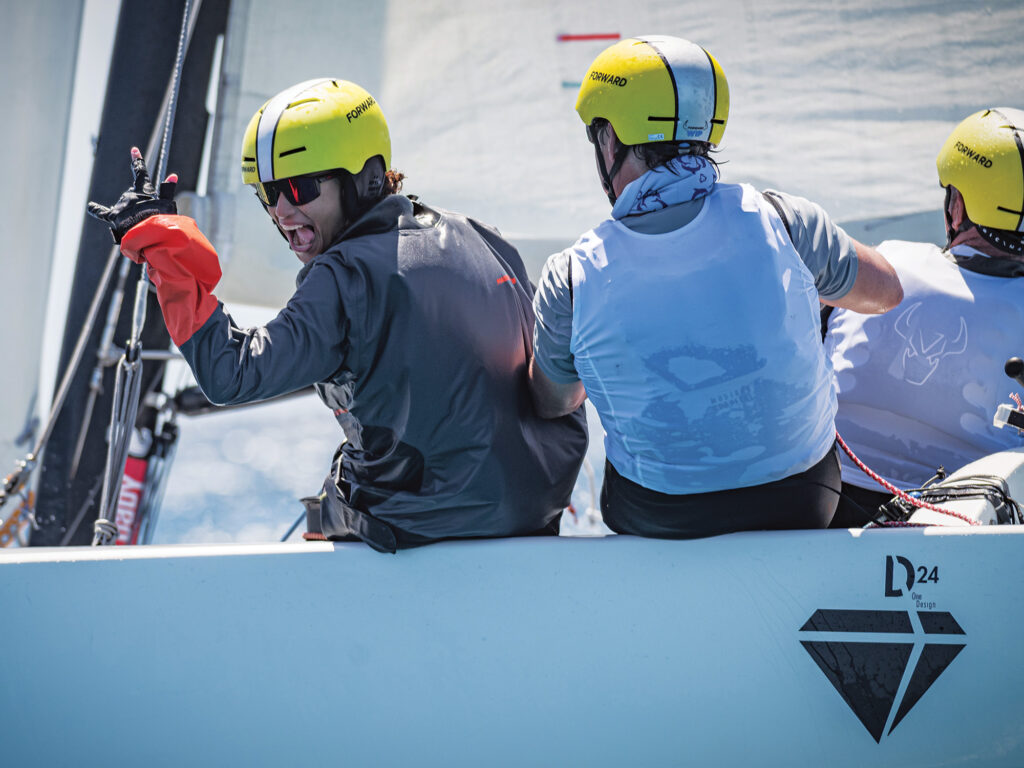
Before we even strike the line on a high-speed gennaker reaching start, Micheaux is shivering, puking, and white-knuckling Altiere’s leg. While redlining at 20 knots, he pats her on the back like a tender father, assuring her that all is well.
We round the reach mark with Micheaux out of commission, so he hands the tiller to me so he can go forward and rotate the mast by hand. It’s my first go at driving, and my tendency is to drive it like a monohull—oversteering through waves and feathering through the big gusts. Altiere corrects me and keeps goading me: “More speed. Even more speed. Good.”
All I have to do is bear away a few degrees, get the center hull unstuck, and the boat levitates with only the leeward bow punching through the waves.
“See?” he says. “Speed. Always more speed.”
After the ensuing and harried one-lap windward-leeward race in the bay, we’re lining up for the 12-mile return sprint, which is another shot-out-of-a-cannon gennaker start. Thankfully, this race has zero upwind sailing. This one’s a reach-fest, and this is why we reach through life.
“The sail back from Marigot was just epic,” Holmes says. “Just screaming. Unbelievably fun. We were finally starting to get a handle on the boat.”
On the fourth and final day, we’re back to buoy racing, and while there’s more tears than cheers on Cry Baby , the sort-of New Yorkers are feeling their mojo.
“We were in the mix,” Holmes says. “We had good starts, and we were with the group upwind. There are some cool photos of us kind of like leading the bulk of the fleet around the course—at least that’s what it looks like.”
Ferraro agrees that they were sharp upwind, “but downwind, we just couldn’t find the low and fast mode. We couldn’t figure that out.”
That’ll be next year’s challenge.
“I’m looking into buying one,” Holmes says, weeks later, back in the office and scheming with Young to go in on it with him. “It’s easy to get to St. Maarten, and from what I’ve seen, they have these cool regattas and beach parties, the sailing is amazing, and it all looks like so much fun. I think about that boat every day, so I definitely have to get back on it.”
Ferraro is hooked as well. “I can honestly say that after all the stuff that went on during the week, good and bad and stuff like that, even with all the chaos and stuff. That was still the most fun sailing I’ve had in a really long time.”
When, and if, they do get their hands on a Diam, there’s only one place they plan on putting it. “If you’re going to do it right, you gotta keep it in St. Maarten,” Young says.
And that’s how Altiere and his St. Maarten crew will get to 20 boats soon enough. If space on Kim Sha becomes an issue, no problem, he says. There are plenty of beaches on St. Maarten to spread the fun around.
“We’ll figure it out,” Altiere says. “I know we can make this work. The dream is real, and there is room for this kind of full-service experience. It’s a gateway to a sailing vacation.”
Sold. More speed coming my way.
- More: One Design , Print Summer 2024 , Racing , Sailboat Racing
- More Racing

Rivals Flush American Magic Facemask Rule Enquiry

The Reemergence of Jimmy Spithill

Running Tide Runs Swiftly Still

Mistakes And Misfires On the Final Day of Cup’s Preliminary Regatta

Emirates Team New Zealand Remain the Bullies of Barcelona

Start-Box Sparring in Barcelona on Day 2 of Preliminary Regatta

Real-time Wind Overlay Feature Added to Cup Broadcast

- Digital Edition
- Customer Service
- Privacy Policy
- Terms of Use
- Cruising World
- Sailing World
- Salt Water Sportsman
- Sport Fishing
- Wakeboarding
- Performance
- Construction
- NEEL 43 PERFORMANCE limited edition
- Rental-Management
- Charter a NEEL trimaran
- LEEN-TRIMARANS
- NEEL-TRIMARANS GROUP
- NEEL OWNERS COMMUNITY
NEEL-TRIMARANS

Design and performance
Neel trimarans are unique sailing boats that brilliantly combine unequalled comfort on board and incredible sailing pleasure. a good balance due to the experience, know-how and skills of a team of passionate people..

Meet us during in La Rochelle during the Grand Pavois (from October 1 to 6, 2024)

Try to win a cruise on a NEEL 43 on our Instragram!

A NEEL trimaran, the perfect sailing boat for an unforgettable adventure
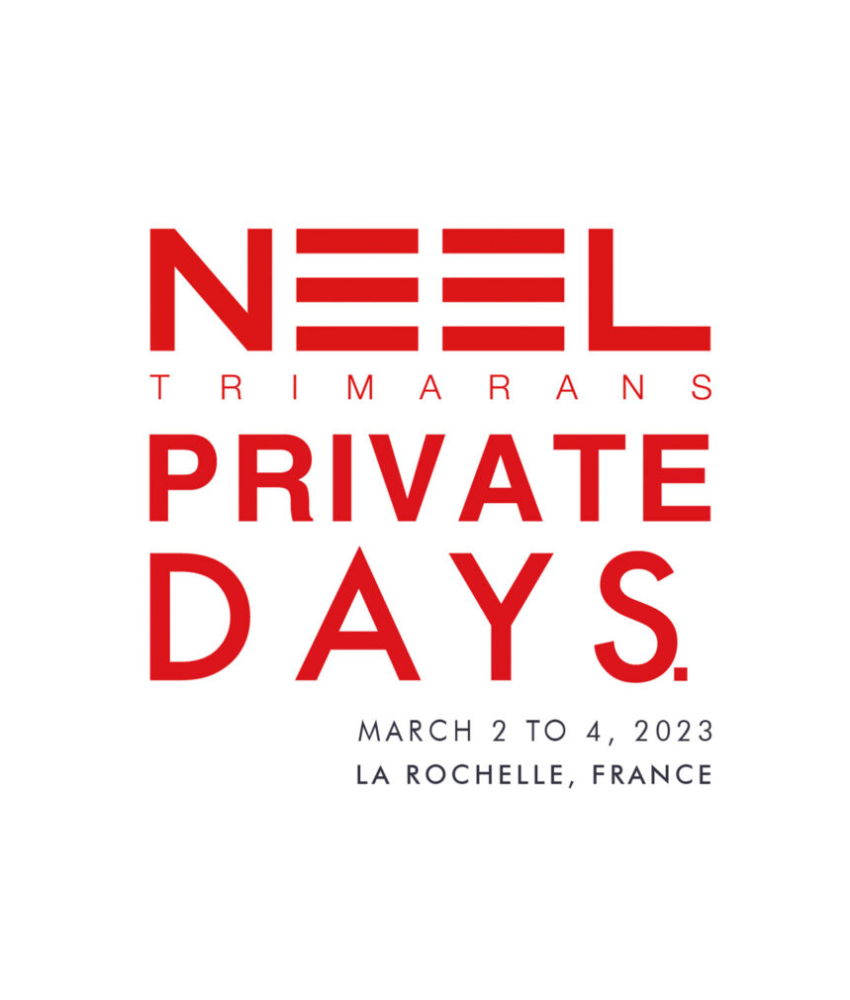
NEEL-TRIMARANS and its dealer network are organising the PRIVATE DAYS in La Rochelle from March 2, to March 4, 2023
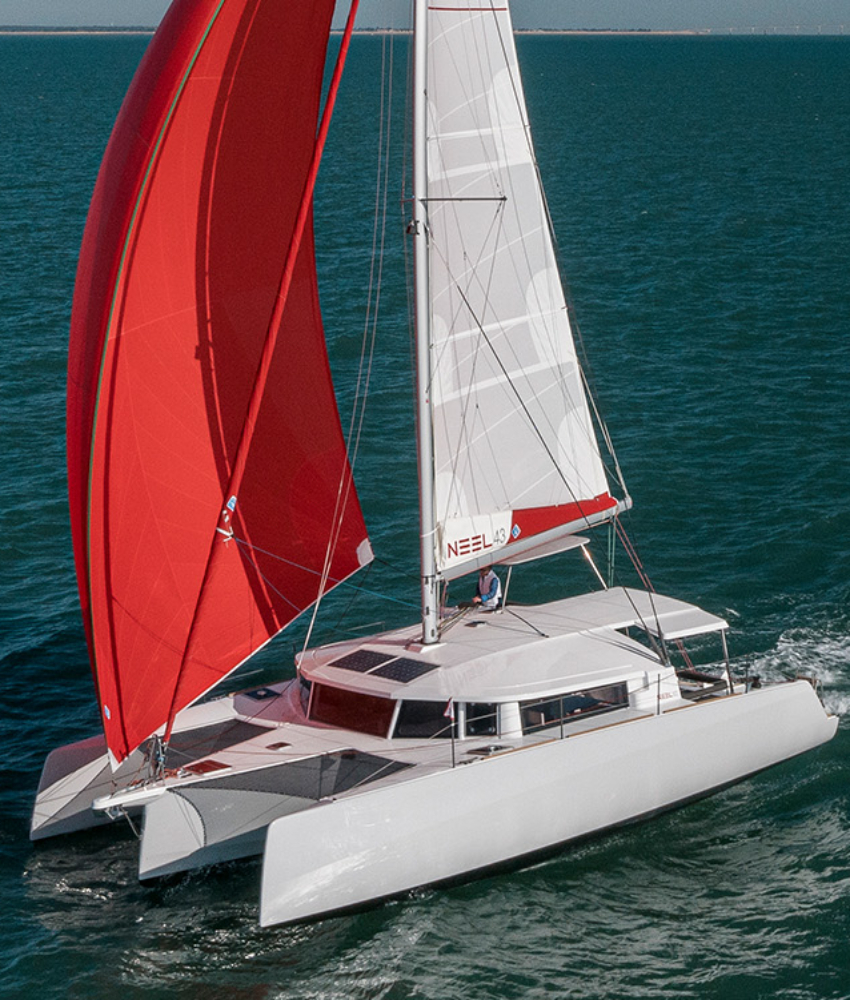
NEEL 43 elected among the top 10 boats of 2023 by SAIL Magazine

The latest Lombard-designed addition to the range is even more innovative and impressive, and with a marked move towards the use of bio-sourced and recyclable materials. The NEEL 43 is available in a limited edition performance version.
The neel 47 successfully combines the benefits of cruising or blue water yacht : safety, performance and comfort living..
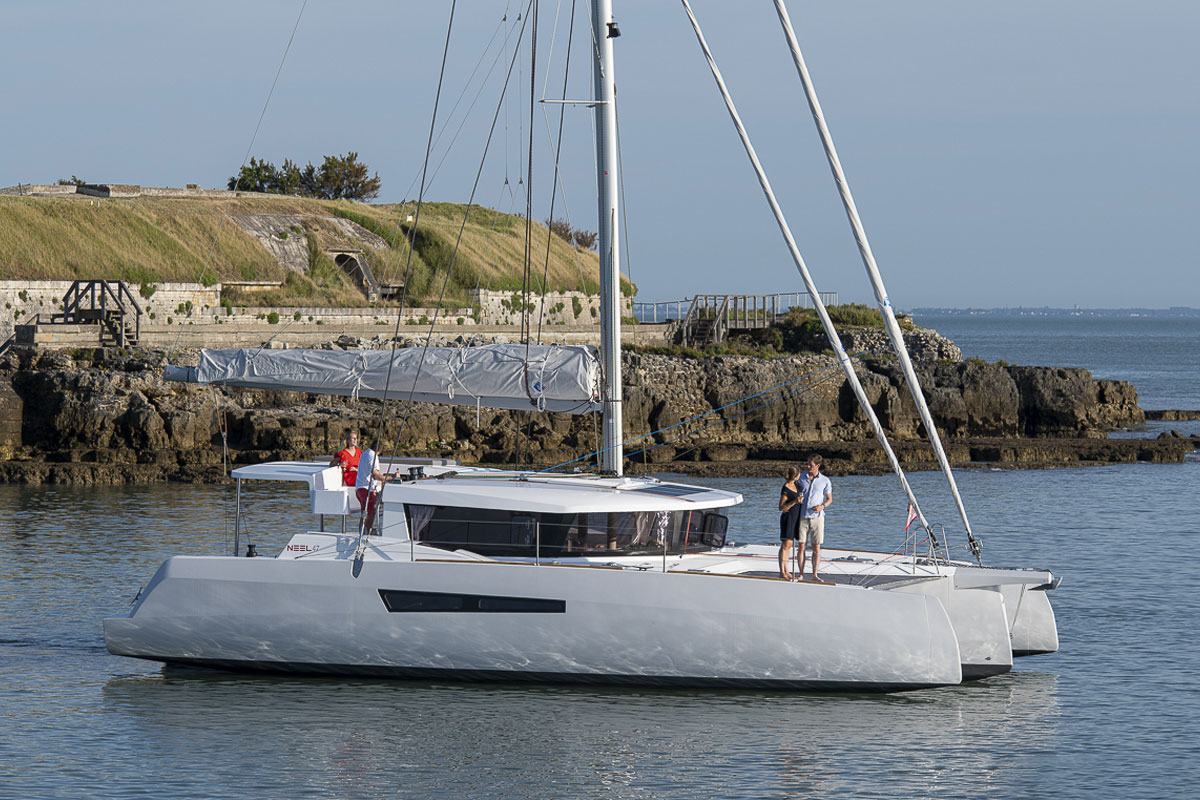
With its racy, modern silhouette, elaborately designed hull and sleek lines, the NEEL 52 exudes power, speed, and elegance. Moving inside and on the deck is smooth and safe.
The neel 65 evolution, the flagship of the fleet, offers unequalled comfort and navigation in "sport-chic" mode..

Privacy Overview
- Legal Notice
- Recruitment
- Private access
ferretti yachts altura 690
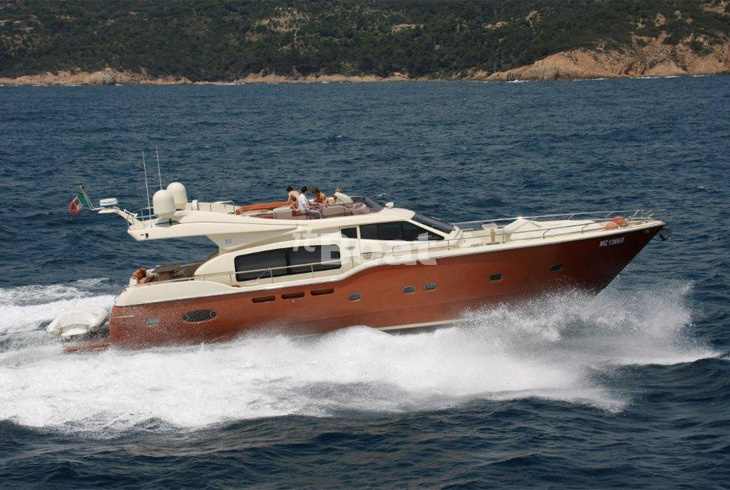

COMMENTS
This trimaran retails for $595,000, making it a cheaper option than the Rapido 60. 5. Dragonfly 40. The Dragonfly 40 measures 40 feet (12 meters) in length. It features high-comfort standards, making it one of the best trimarans in the market for taking your family for a cruise.
Trimaran sail trim. One of the biggest differences between a cruising monohull and a multihull is how the mainsail is trimmed. Leech tension on a yacht is often largely controlled by the kicker and the backstay, while the mainsheet sheets the mainsail in and out, predominantly controlling the angle of the boom to the centreline, and there may be a short traveller.
Known for their award-winning luxury trimarans, NEEL is based in La Rochelle, the capital city of sailing in France. NEEL trimarans are built for fast cruising with an average cruising speed of about 10 knots, and are even configured to facilitate that sustained speed under motor propulsion. The NEEL 45 was notably named Cruising World's Most ...
Trimaran sailing vessels for sale on YachtWorld are offered at an assortment of prices from $19,364 on the relatively more affordable end all the way up to $1,828,394 for the most luxurious model vessels. Trimaran By Condition. Used Trimaran 106 listings . New Trimaran 51 listings .
MULTIHULL of the YEAR 2022! „MARLIN 33" By MARLIN TRIMARANS. JUERGEN TERIETE. light speed marine is run by Juergen Teriete, sailing enthusiast and "everything-sailor" from childhood with 40 years sailing experience and enthusiasm. Starting with regatta sailing on the 420, through numerous racing dinghies and F18 catamarans to countless holiday trips on cruising yachts and catamarans of ...
For their size, trimarans can punch well above their weightin speed, cruising potential, and fun. Monohull sailorTheo Stocker gets to grips with how to handl...
Above: A Rapido 60 Trimaran underway sailing on the water. Vessel Overview: Concept And Design. The Rapido 60 was designed by premier California firm, Morrelli and Melvin (M&M). It came to life after a discussion between Pete Melvin (of Morrelli & Melvin) and Paul Koch (of Rapido trimarans) who chatted during the runup to the New Zealand ...
The new Rapido 40 trimaran is designed by Morrelli & Melvin, whose portfolio includes multihull rockets ranging from America's Cup contenders to Steve Fossett's Playstation, so no surprise that performance is in its DNA.But it's also a cruising multihull that's light, strong, easy to sail, and designed to fit into a standard slip, with retractable amas.
Sailing World Magazine's Best Multihull of 2024 is the Dragonfly 40 trimaran, a luxury and high-performance sailboat designed and built for experienced bluewater sailors and cruisers.
Above: A 2023 NEEL 43 Trimaran Sailing Yacht underway. Photo by Olivier Blanchet / NEEL-Trimarans. The NEEL 43 is a Marc Lombard design with a Z-Spar fractional rig and a five-foot fixed keel. The construction includes a vinylester sandwich with carbon reinforcements in high-load areas. A new twist is the use of flax cloth in the layup.
Here are 6 of the best trailerable trimaran: The Dragonfly series. F-22. Corsair Series. Astus. Weta 14.5. Windrider 17. Choosing the best trailerable trimaran (a multi-hull with three "hulls") will depend on crucial factors like speed, durability, design, and ease of transportation.
Want to find out more? HONG KONG (Registered office): Rapido Trimarans Limited. RM 3602, Level 36, Tower 1, Enterprise Square Five. 38 Wang Chiu Road, Kowloon Bay, Kowloon, Hong Kong. Email: [email protected]. Ph.: +84 2836363220. VIET NAM (Factory): Triac Composites Company Limited. Factory No. 4, 9 Nguyen Van Tao Street.
Price as reviewed: We're beating out of the approach channel to La Rochelle in 8-10 knots of true wind, with some tacks as short as 90 seconds. The yacht is tacking cleanly and accelerating ...
A stainless steel bolt on the inboard end of each beam secures the floats for sailing. Crucially, wingnets remain attached during the folding process - their frictionless fixing allows them to tension themselves appropriately through the folding process. The system is so simple and balanced that Corsair trimarans can even be folded while ...
NEEL 43 Sailing The NEEL 43 is a trimaran that is both fast and safe, yet easily manoeuvrable by a small crew. Its handling at sea, coupled with its performance and comfort levels are outstanding.
The Dragonfly 28 comes in both a Touring and Sport version, and, introducing 2016 the new Dragonfly 28 Performance version. Discover the evolution of a popular model. Introducing high volume wave piercing floats for fast and relaxed sailing. Quality combined with performance secures an outstanding experience.
The flagship of the range Sail in a new way with the NEEL 65… A new and unique angle on cruise-oriented navigation, in "Sport-Chic" mode. The furniture design code, in a highly contemporary style using simple and refined materials. The saloon with its sleek lines, enjoys a wide panoramic view. GALlERY Photos and videos NEEL […]
With a spark plug in St. Maarten multihull maven Pierre Altier, the Diam 24 One Designs have become the hot fleet in the islands. ... The sail is board-flat and the telltales are streaming.
A NEEL trimaran, the perfect sailing boat for an unforgettable adventure. NEEL-TRIMARANS and its dealer network are organising the PRIVATE DAYS in La Rochelle from March 2, to March 4, 2023. NEEL 43 elected among the top 10 boats of 2023 by SAIL Magazine. The latest Lombard-designed addition to the range is even more innovative and impressive ...
SAIL New Boats & Gear 2025 is here and it's chock-a-block with new boat reviews by SAIL's boat review team, info on the latest models hitting the water, and gear SAIL's editors have checked out as well.It's available on newsstands, so head to your nearest West Marine or Barnes & Noble, or catch us at the U.S. Sailboat Show in Annapolis in October to say hi and get your issue.
Find Trimaran boats for sale in United States. Offering the best selection of boats to choose from.
ASIA PACIFIC; Ferretti Altura 690: a return to the values of a winning philosophy. Saturday, January 15, 2005. DISCOVER MORE. Thursday, April 14, 2005. Ferretti Yachts awarded at
2-cabin sailing yacht Antila 27 - Elba was built in 2003 and it is docked in Kabel'shchik Yacht Club, Russia.. Elba is suitable for up to 9 people for a daily charter. Sailing yacht Elba offers 1 toilet.. Boat equipment features classic mainsail.The fully-equipped galley includes a cooker, sink and kitchen utensils.. This sailing yacht is operated by the charter company Arta Perm.
5 August official daily competition schedule and live results for Paris 2024. Find out which athletes are taking home medals for which countries.
Lysva as a settlement was known in the middle of the 17th century. The lands around Lysva in the second half of the 18th century were inherited by the daughter of Baron Stroganov, Princess Shakhovskaya.In 1785 construction of the cast-iron foundry began.
Perm Krai is located to the east of the East European Plain and the western slope of the Middle Ural Mountains. 99.8% of its area is in Europe, 0.2% in Asia.The maximum length from north to south is 645 km, from west to east — almost 420 km. The borders of the region are winding and have a length of more than 2.2 thousand km. [12] length from north to south - 645 kilometres (401 mi)